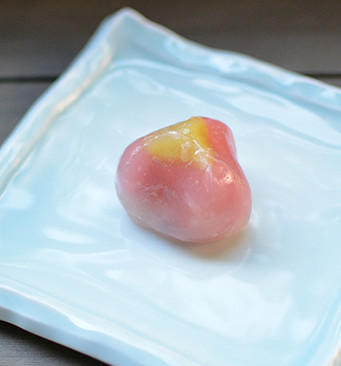
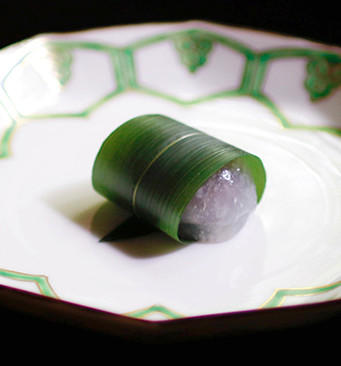
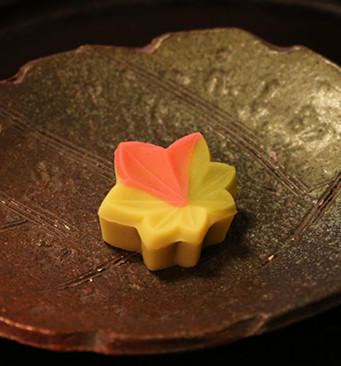
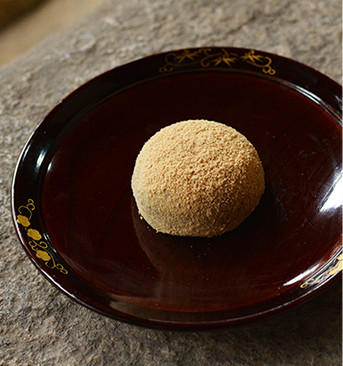
January
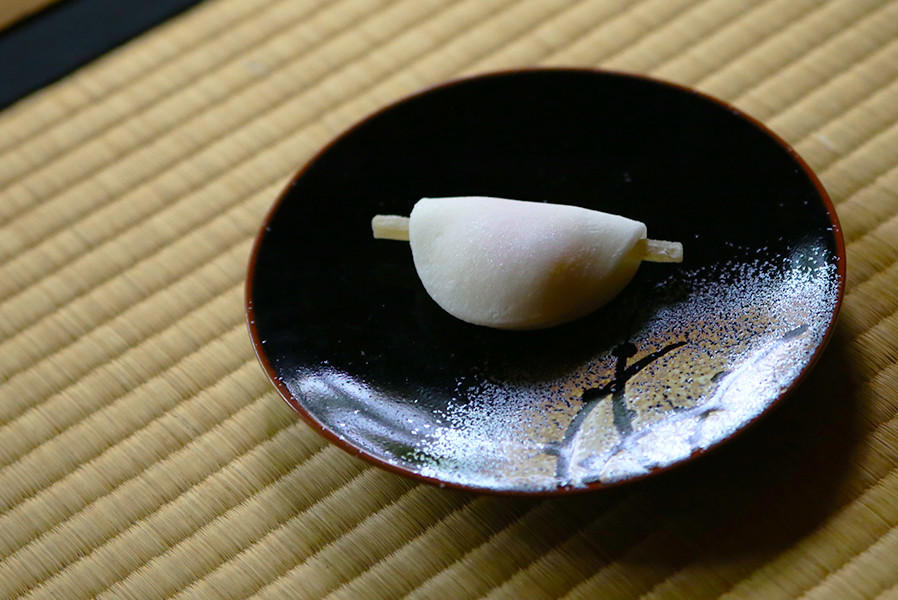
Hanabira mochi
Hanabira mochi represents the ornaments on the Kagami-mochi (a mirror shaped rice cake offered at New Year) used at the Oha-gatame (a ceremony conducted in the imperial palace to wish for longevity). The light crimson of the habutae mochi (a very smooth and soft rice cake) brings a sense of spring. The great burdock originates from pressed sweet fish, and the miso paste from soup with rice cake inside.
Designated Material : Eggs, Soybeans
Best-before period : 3 days
Kasane Ume
The plum blossoms flourish in late winter, bringing the first hint of spring.
As well as pine trees and bamboo, plum blossoms have been said to represent happiness from the ancient times. The petals of the plum blossoms are expressed with thin layers of konashi (soft sweet baked bean paste molded by hand). We have been making Kasane Ume as a New Year specialty for many years.
Designated Material: Japanese yam
Best-before period : 2 days

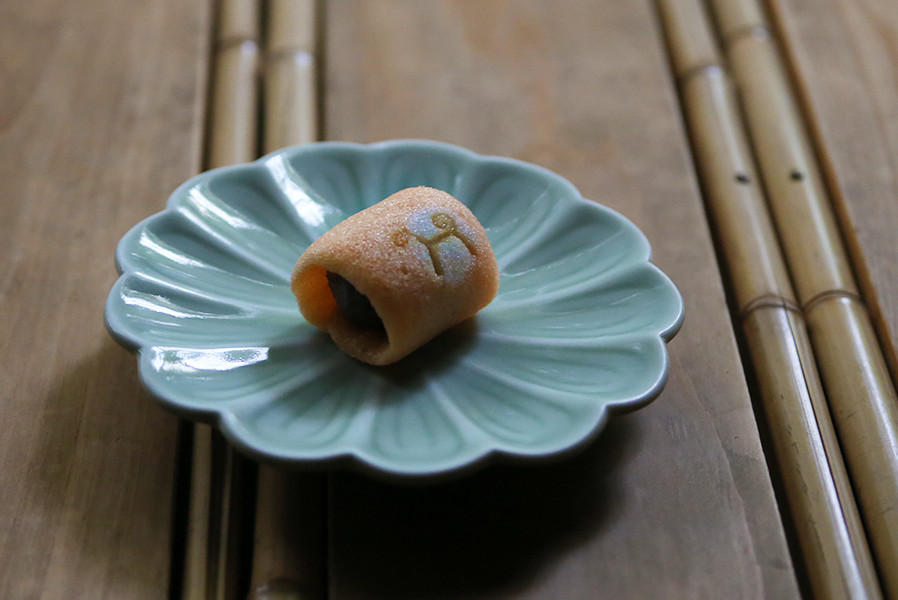
Etoka Inu
2018 is the year of the dog.
Dogs have been a guardian deity for a safe childbirth, since they give birth to many offspring, while hardly suffering at all. Etoka Inu is made of wrapping baked sweet beans around Karukan (steamed sweet bun made from grated yam and rice flour).
Designated Material : Japanese yam
Best-before period : 2 days
Yuki no Matsu
With the white nerijyo-yoan, potato paste made of Jyo-yo potato, on minced white baked beans tinted with green, we have expressed the pine trees, standing strong in the snow.
Designated Material : Japanese yam
Best-before period: 2 days
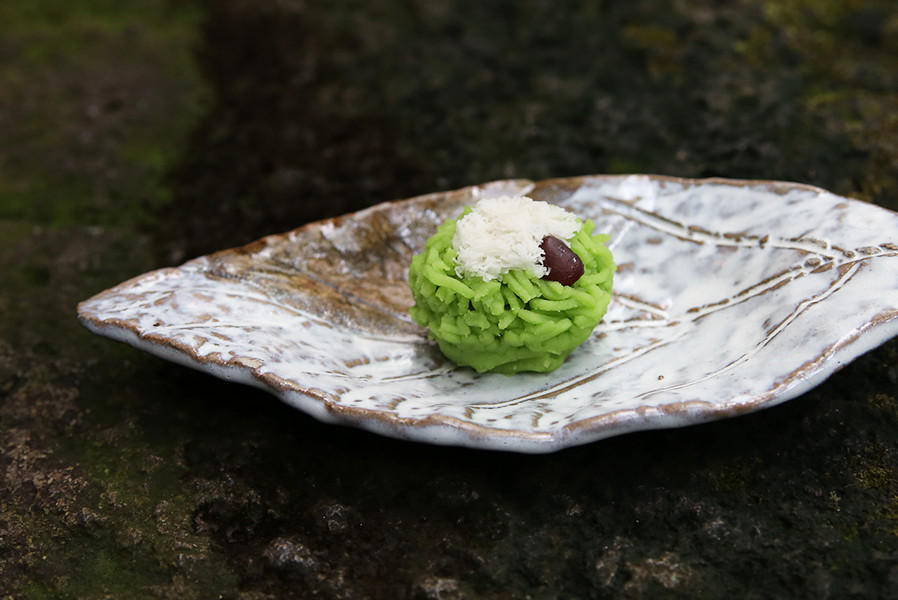

Fuji-enbou
The red dawn of early spring with the sacred mountain, Mount Fuji, in the background.
The Fuji-enbou is made of jelly made from the roots of kudzu and agar mixed with meringue, put together into one cake.
Designated Material : Japanese yam
Best-before period: 3 days
Tsubaki mochi with brown sugar
The tsubaki mochi was imported from China along with other sweets, back in the Heian period.
Roughly mashed sweet beans wrapped in brown sugar scented domyouji (a type of rice cake with a lumpy texture), sandwiched by the leaf of a Japanese camellia.
Designated Material : None
Best-before period: 2 days
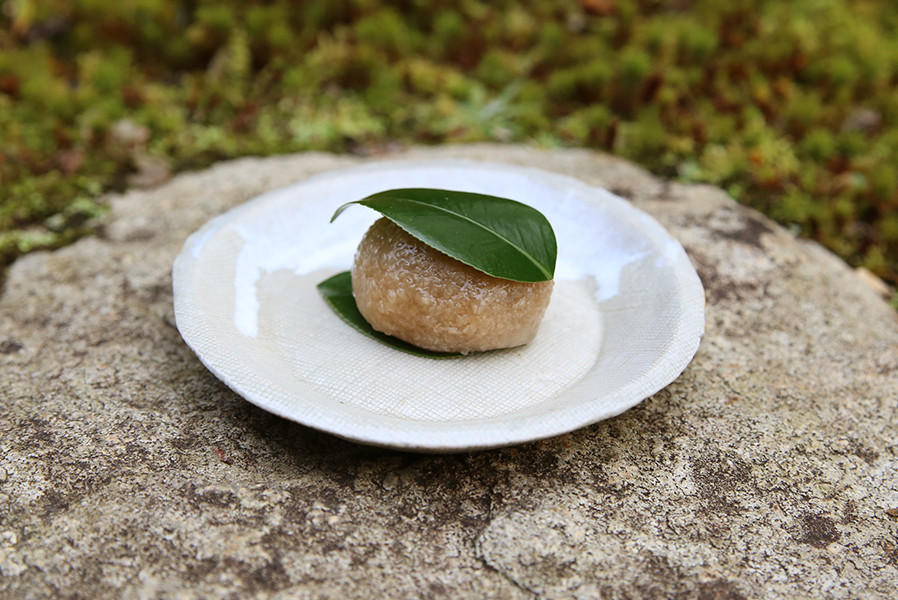

Uguisu mochi (Bush warbler)
The uguisu mochi is made with mashed sweet beans wrapped in a thin layer of rice cake, and powdered with uguisu kinako (powdered green soybeans). It is so named since it is colored and shaped like the feathers of a bush warbler.
Designated Material: eggs, soybeans
Best-before period: 2 days
Koubai
The innocent and graceful plum blossoms flourish in early spring. The red tinted white mashed beans and roughly mashed sweet beans are wrapped in bracken starch, representing the beauty of the plum blossoms.
Designated Material : Japanese yam
Best-before period: 2 days

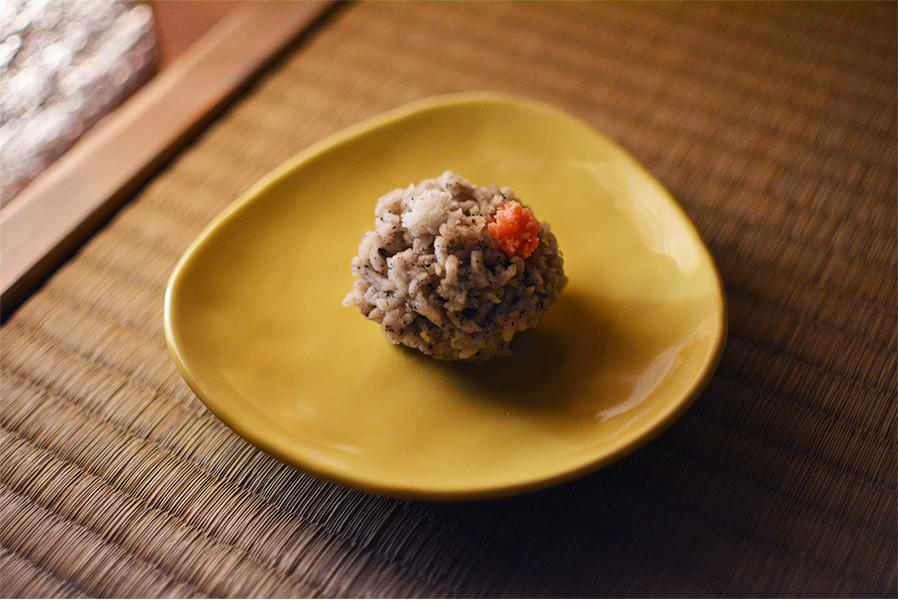
Umegaka
The scent of a plum is said to drift a long distance, and has been featured in poems from back in ancient times.
The Umegaka is made of black sesame mixed in smoothly mashed sweet white beans. The nerijyo-yoan (potato paste made of Jyo-yo potato) tinted in red and white is shaped into flower petals.
Designated Material : Japanese yam, sesame
Best-before period: 2 days
Kono-hana
Kono-hana is a poetic way of referring to plum blossoms in Japan.
A plum blossom is branded on sweet mashed beans wrapped in grated yam.
Designated Material : Japanese yam
Best-before period: 2 days
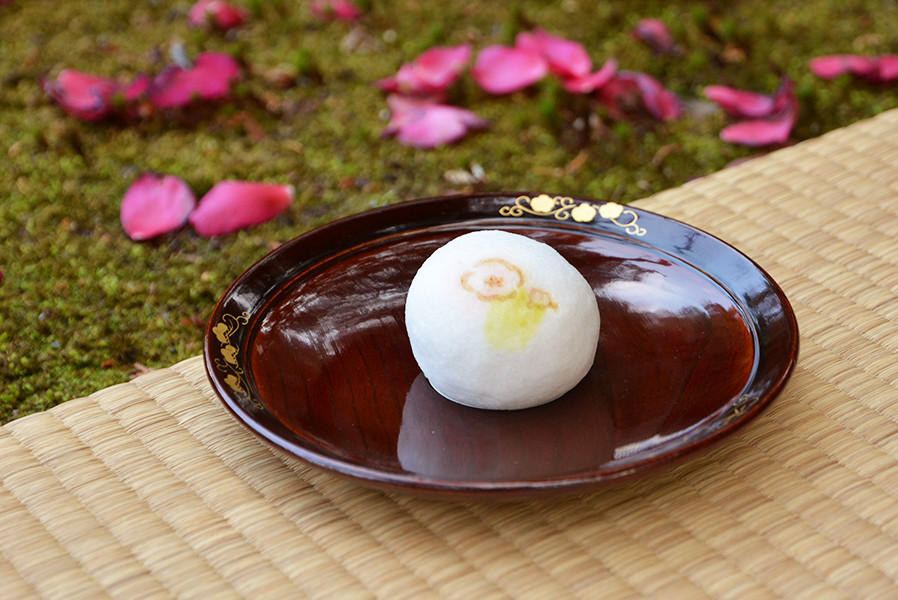
February
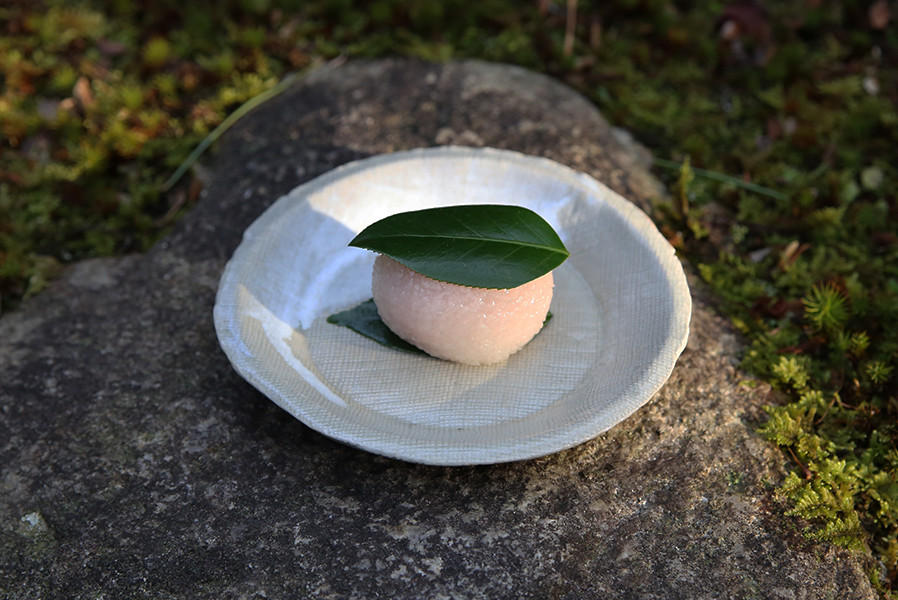
Tsubakimochi
The Tsubaki mochi was imported from China along with other sweets, back in the Heian period.
Tsubakimochi is finished with domyouji (a type of rice cake with lumpy texture).
Designated Material : eggs
Best-before period : 2 days
Mado no Ume
In the severe cold, the plum blossoms bloom to bring us news of the coming spring. Through the underground window of the hermitage is the glowing beauty of a flower, expressed by the use of konashi (soft sweet baked bean paste molded by hand).
Designated Material : flour, Japanese yam
Best-before period: 2 days
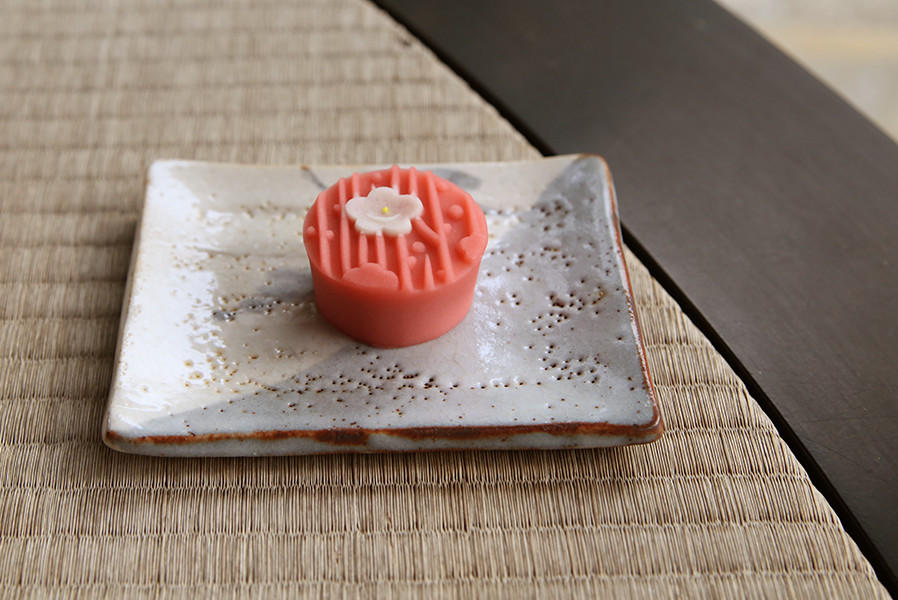
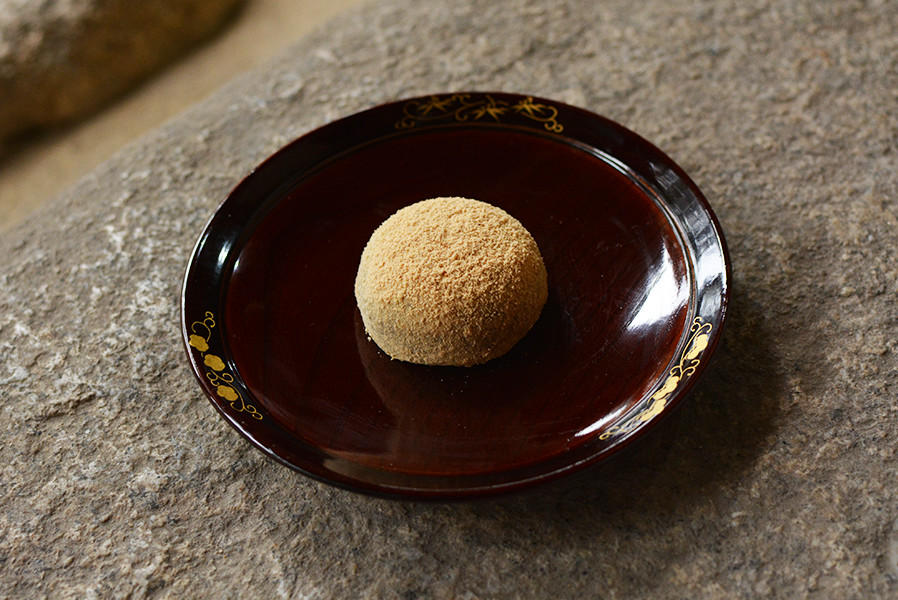
Warabiyama (Warabi Mountain)
The warabi mochi (bracken rice cake) was widely used as a snack offered with green tea. Kneaded bracken-root starch is wrapped around the sweet baked beans, powdered with kinako (roasted soybean flour). The silhouette, resembling mountains, is the origin of its name : Warabiyama (warabi mountain).
Designated Material : soybeans
Best-before period : 2 days
Harube
Harube depicts the plum blossoms flourishing in the early spring, by coloring the smoothly mashed white soybeans red and white.
Designated Material: flour
Best-before period: 2 days
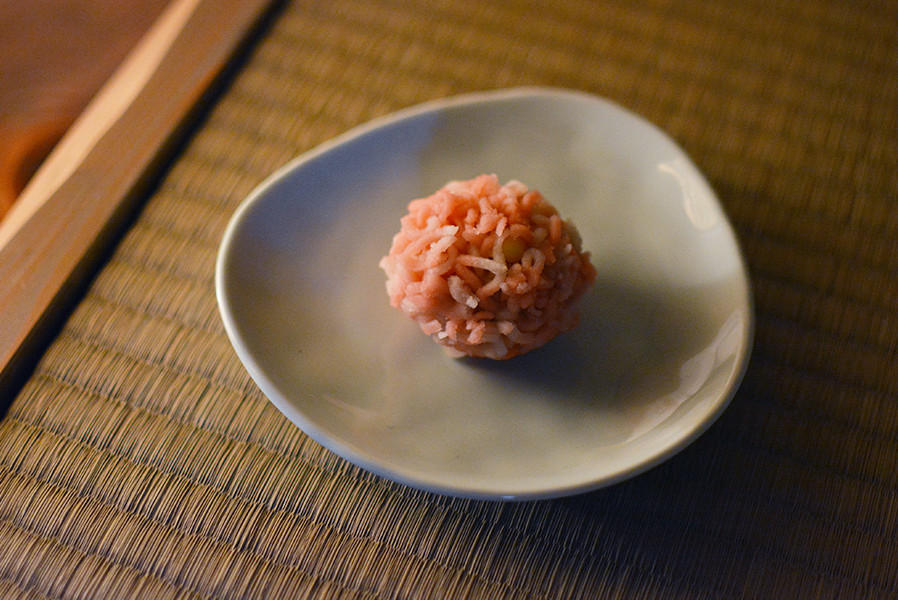
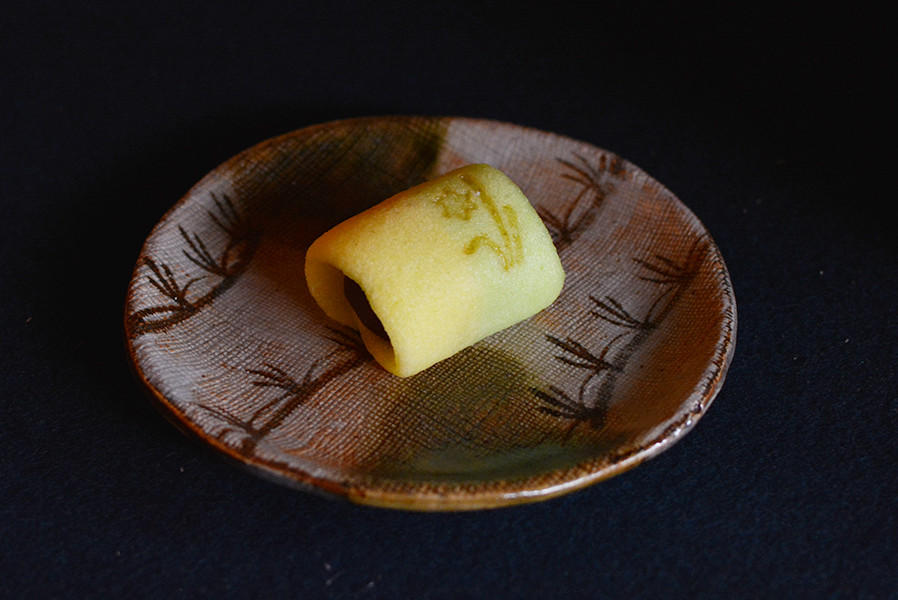
Suisenka
The suisenka (narcissus) flourishes proudly in the frigid air of winter. Red sweet baked beans are wrapped with karukan (steamed sweet bun made from grated yam and rice flour) colored yellow and green.
Designated Material : Japanese yam
Best-before period: 2 days
Yomogi mochi
Since the scent of the yomogi *(Rice cake mixed with mugwort) was said to drive the evil spirits away, it was mixed into rice cakes while people also enjoyed the hint of spring hidden in the flavor. Rice cake wafers with the taste of Yomogi are wrapped around the sweet baked beans: a Japanese sweet you cannot miss out on during Spring.
Best-before period: 2 days
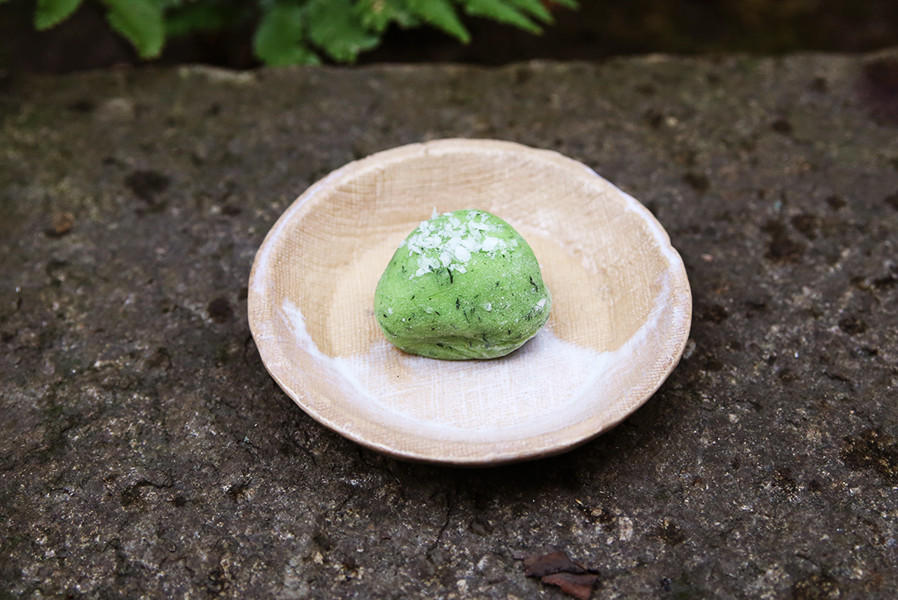
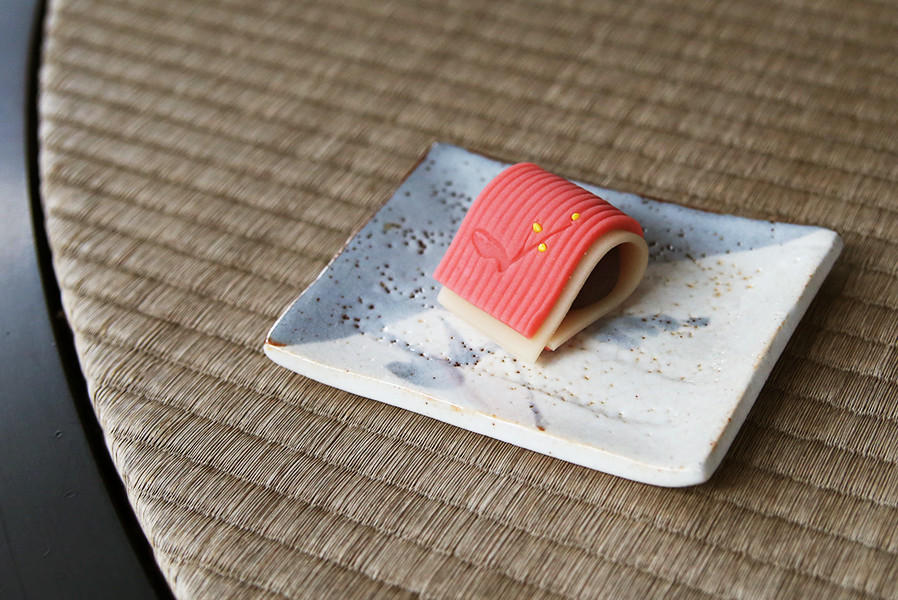
Tagasode
The scent of plum blossoms and the gorgeous outfit from the Momoyama period (1583-1600 CE), are expressed by folding the mashed red beans with the konashi (soft sweet baked bean paste molded by hand).
Designated Material : flour
Best-before period: 2 days
Warabiyama
The yomogi-mochi (rice cake mixed with mugwort) was widely used as a snack offered with green tea. Kneaded bracken-root starch is wrapped around the sweet baked beans, powdered with kinako (roasted soybean flour). The silhouette, resembling moutains, is the origin of its name : Warabiyama (warabi mountain).
Designated Material : soybeans
Best-before period: 2 days
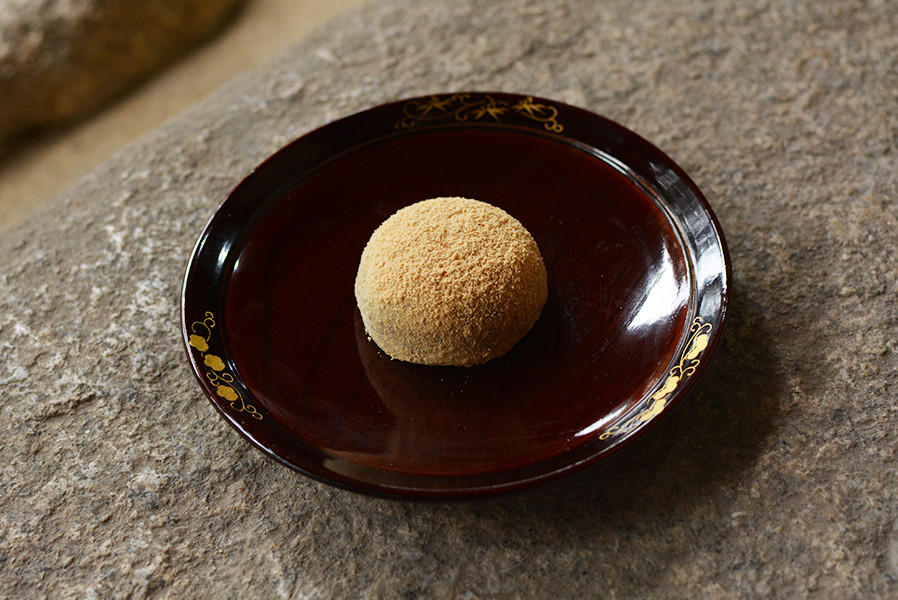
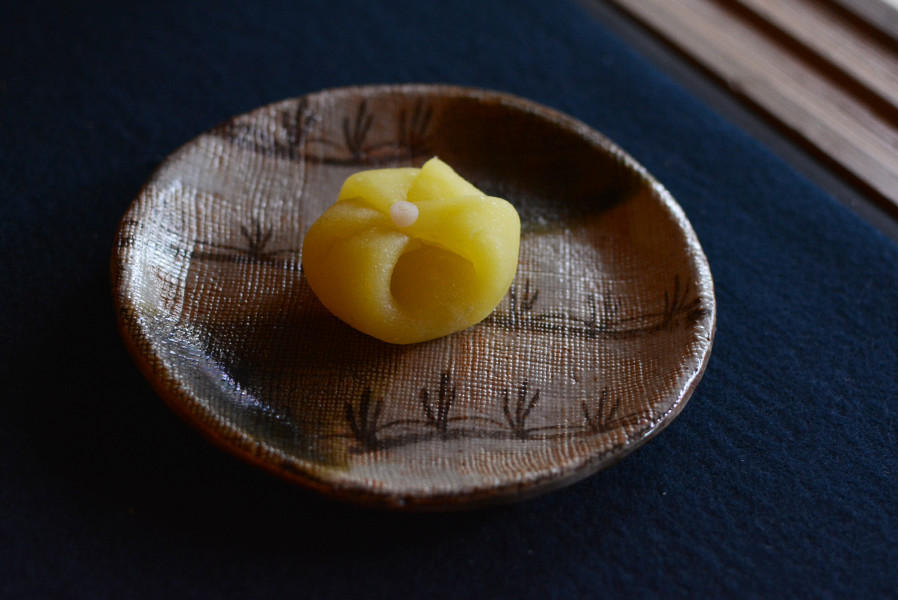
Kizuisen
Kikuizen is a narcissus innocently blooming in the severe cold. Sweet rice jelly is wrapped around the sweetly baked white beans, and shaped into a flower.
Designated Material: flour
Best-before period: 2 days
Shita moe
The baked sweet beans scented with brown sugar and a mixture of Nerijyo-yoan (potato paste made of Jyo-yo potato) and sweet red beans, express the grass buds sprouting powerfully from beneath the snow (shita moe).
Designated Material: Japanese yam
Best-before period: 2 days
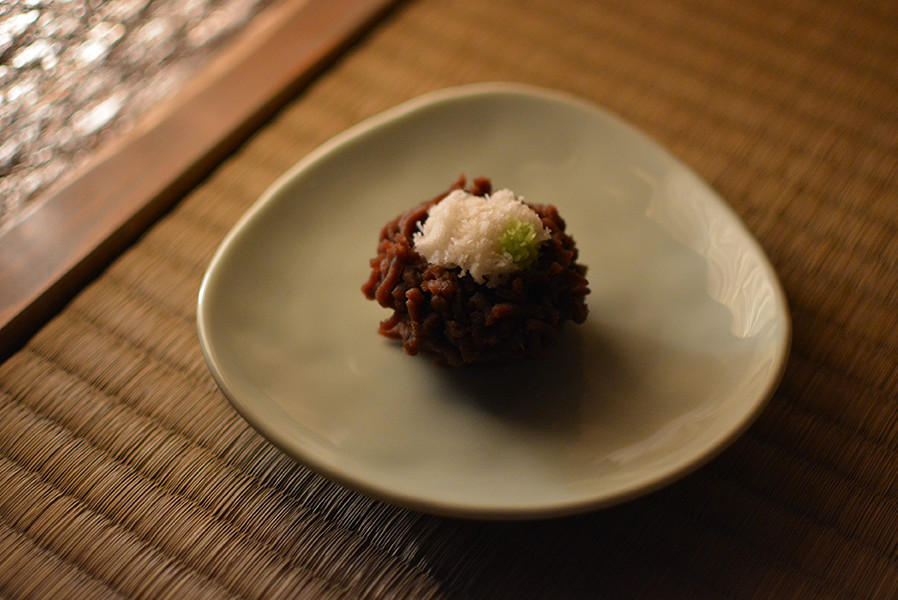
March
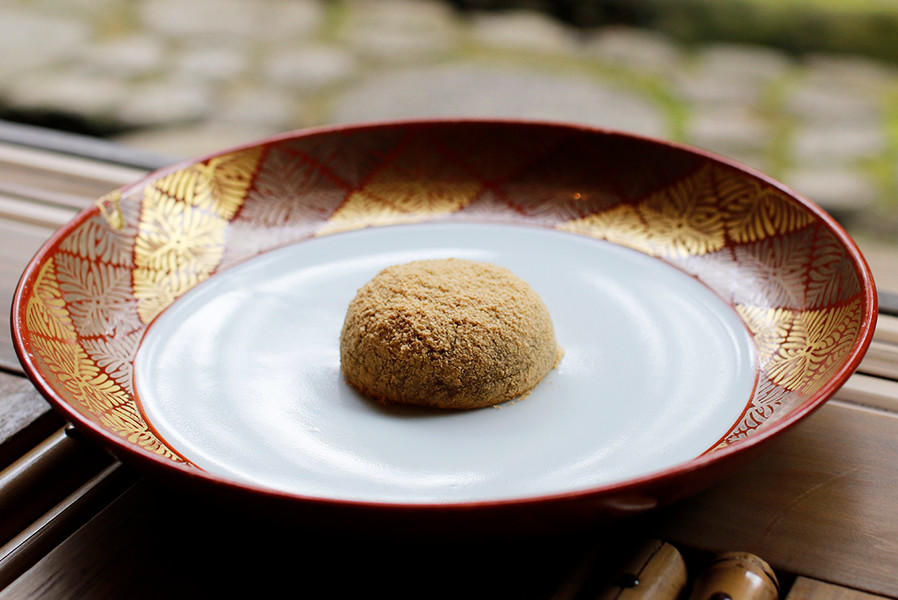
Warabiyama (Warabi Mountain), made of bracken starch.
The warabi-mochi (bracken rice cake) was widely used as a snack offered with green tea. Kneaded bracken-root starch is wrapped around the sweet baked beans powdered with kinako (roasted soybean flour). The silhouette, resembling mountains, is the origin of its name : Warabiyama (warabi mountain).
Designated Material : soybeans
Best-before period: 2 days
Haru Biyori made of karukan (steamed sweet bun) and steamed bean paste.
The wild flowers flourishing in the fields announces the arrival of spring. With rhe karukan (steamed sweet bun) and steamed bean paste together frosted with minced-sweet beans, we have expressed the features of spring.
Designated Material : Flour, Japanese yam
Best-before period: 2 days
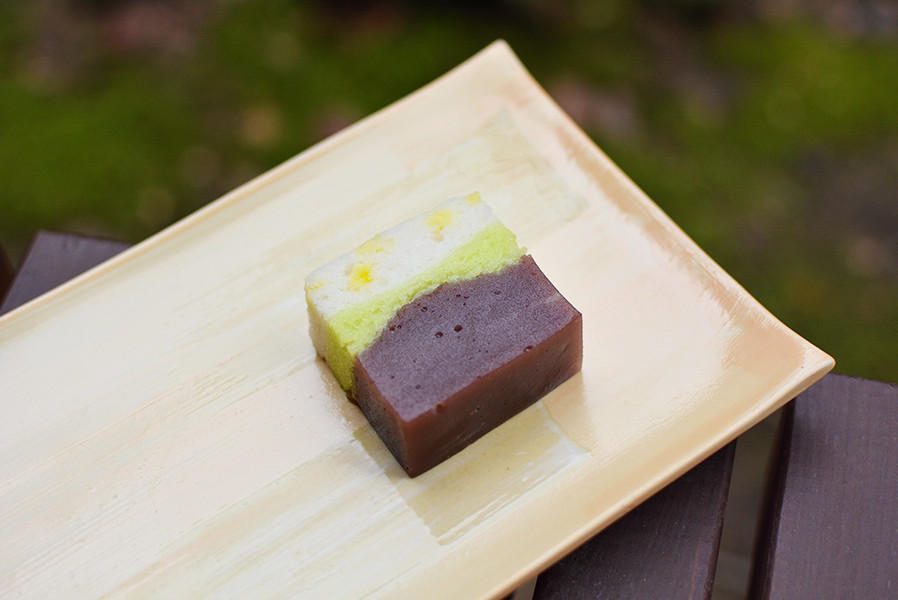
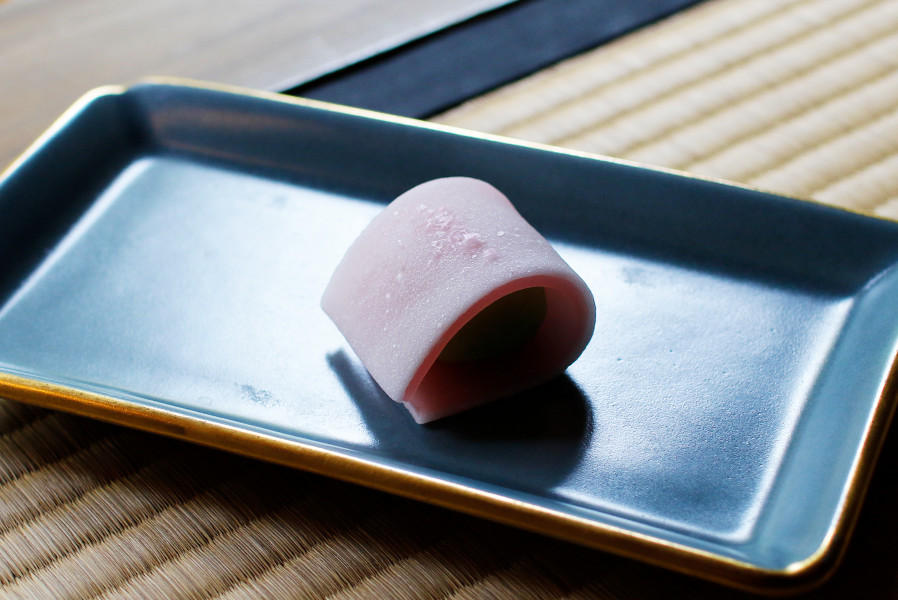
Hana Goromo made of rice cakes and sweet bean jelly.
Like clothing of many colored layers. It is made of rice cake and sweet bean jelly, depicting the beauty of the fluttering dance performed in a gorgeous outfit under the flourishing cherry blossoms.
Designated Material : Egg
Best-before period: 2 days
Na-no-hana Kinton (Rape flower kinton) made of kinton
The golden Na-no-hana (rape flowers) filling the farm, notifies us of the arrival of spring. It is made of red bean paste wrapped with konashi (soft sweet baked bean paste, molded by hand).
Designated Material : Japanese yam
Best-before period: 2 days


Momo no Hana made of Kinton
Since Momo (peach) is said to chase evil spirits away from back in the old days, the Momo no Sekku (puppet festival) is held to pray for young girl's growth and happiness under the protection of the Momo. Sweet bean paste is wrapped with konashi (soft sweet baked bean paste molded by hand), and shaped into the peach blossoms with a wooden pattern.
Designated Material: flour
Best-before period : 2 days
“Warabiyama” (Warabi Mountain), made of bracken starch.
The warabi-mochi (bracken rice cake) was widely used as a snack offered with green tea. Kneaded bracken-root starch is wrapped around the sweet baked beans powdered with kinako (roasted soybean flour). The silhouette, resembling mountains, is the origin of its name : Warabiyama (warabi mountain).
Designated Material : soybeans
Best-before period: 2 days
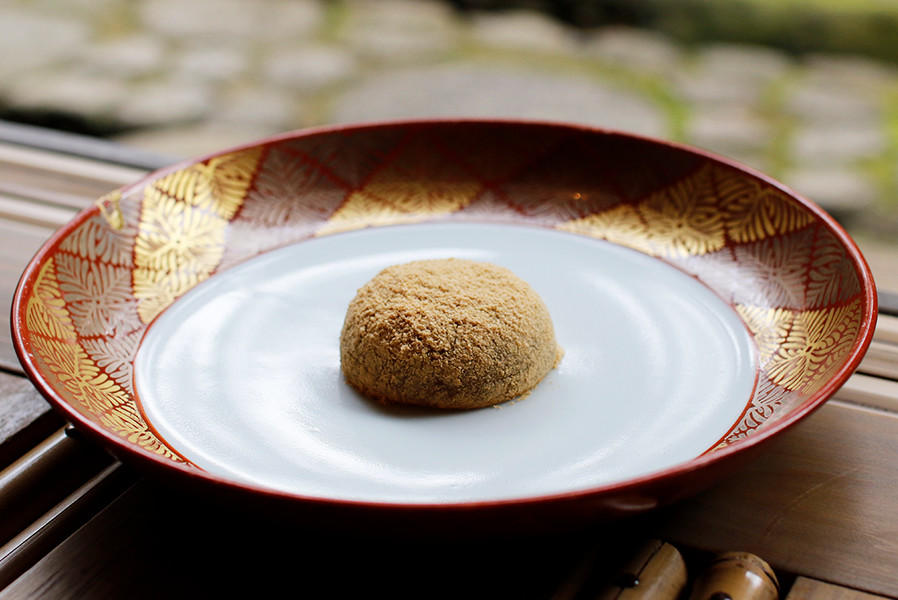

Haru no Mizu made of konashi.
The cherry blossoms are even more beautiful when seen with the water, bathed in soft sunlight, trickling on a nice spring day. We have expressed the arrival of spring by wrapping the sweet bean paste in a light-blue and white colored konashi (soft sweet baked bean paste molded by hand).
Designated Material : Flour
Best-before period: 2 days
Yayoino made of uirou
Wrapping the baked sweet beans with the sweet rice jelly coming in three colors, we have expressed a peaceful spring, with the grass and trees beginning to sprout and blooming flowers lit by the warm sunlight.
Best-before period: 2 days


Tsukushinbo made of karukan
The horsetail peeps out from the earth in the field, as one of the first signs of the arrival of spring. Baked sweet red bean paste wrapped in karukan (steamed white bun).
Designated Material : Japanese yam
Best-before period: 2 days
Yoshino Yama made of kinton.
In contrast to the beauty of flowers which bloom alone, the cherry blossoms display their characteristic beauty by coming together to flourish in a bundle. A Japanese sweet depicting the Yoshino mountain spring in full bloom, with the minced- white bean paste.
Designated Material: Japanese yam
Best-before period: 2 days
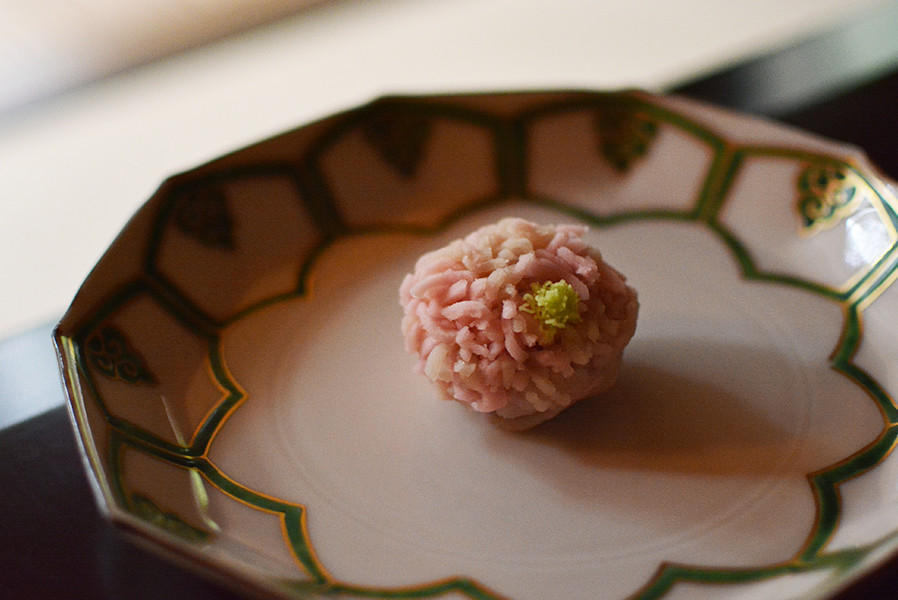
April
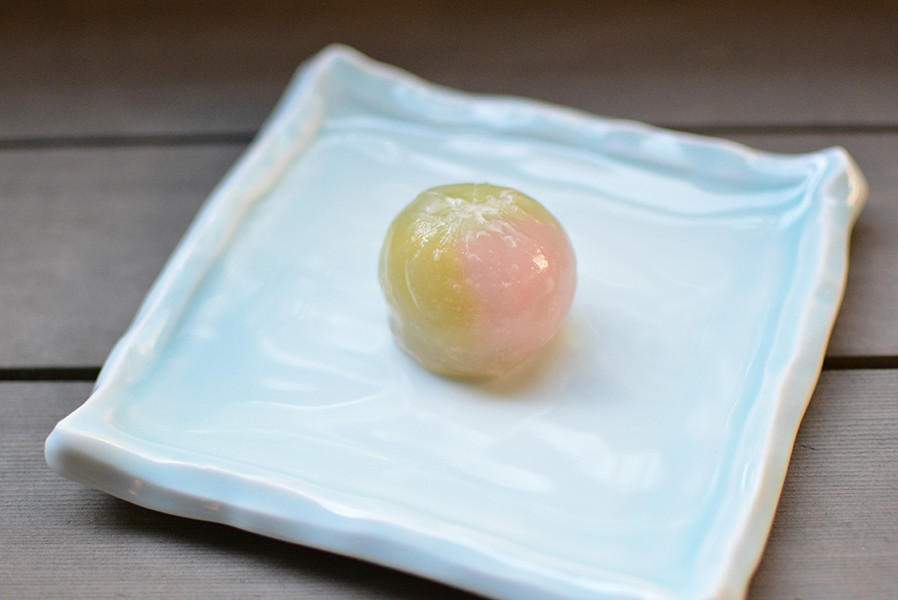
Haru Geshiki (Spring view)
Sweet baked red beans wrapped in yoshino kuzu (made of arrowroot from Yoshino, Nara) and finished with chakin shibori (a way of shaping soft paste by wrapping it in fabric and squeezing it). Haru Geshiki depicts the sprouting of trees, the blooming of flowers, and the glittering sunlight bringing about the beauty of spring.
Best-before period : 2 days
Hana Kurenai
The cherry blossoms are reflected in the flowing river, bathed in the warm spring sunlight. A pink-tinted karukan (steamed sweet bun) rolled with sweet baked beans, resembling the coming of spring.
Designated Material : Japanese yam
Best-before period : 2 days
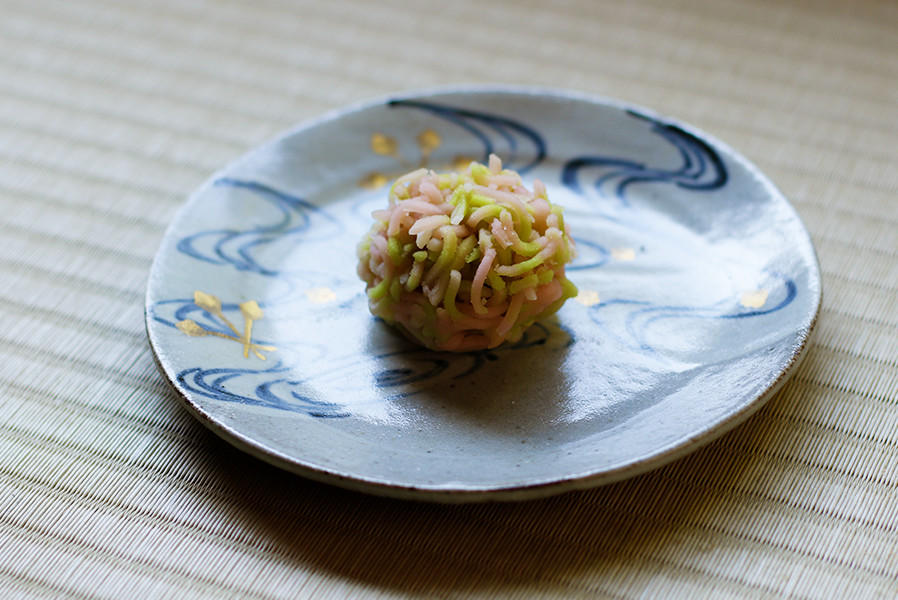
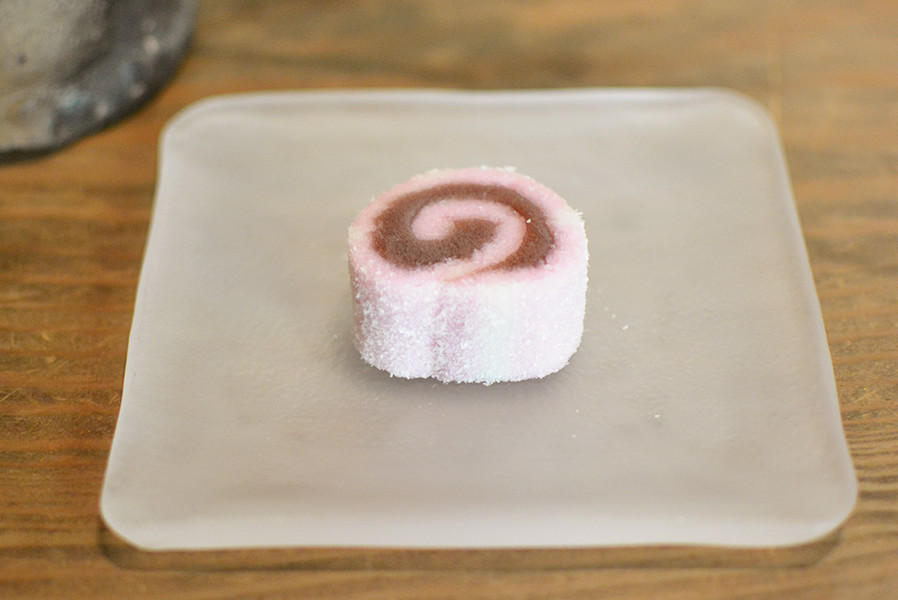
Sakura-gawa (Sakura river)
The cherry blossoms are reflected in the flowing river, bathed in the warm spring sunlight. A pink-tinted karukan (steamed sweet bun) rolled with sweet baked beans, resembling the coming of spring.
Designated Material : Japanese yam
Best-before period: 2 days
Tsumi Kusa (Picking plants)
Feel the true nature of spring by picking the plants and flowers blooming in the fields and tossing them into a basket. Tsumi Kusa is made by folding pink-tinted baked white beans in a "uirou" (sweet rice jelly) dough.
Designated Material : flour
Best-before period: 2 days
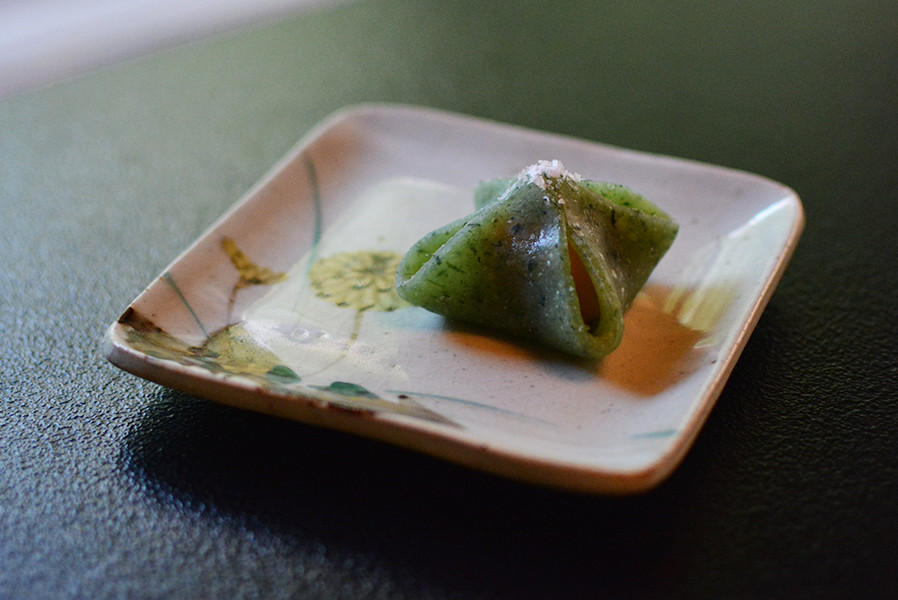

Hana no Yama (Mountain of flowers)
A pink shaded "Koori-mochi" (dried rice cake) sprinkled on mashed white beans scented with cherry blossoms, wrapped in soft rice cake wafers. This sweet expresses what many of us imagine when we hear the word "spring".
Designated Material : Egg
Best-before period: 2 days
Kirishima
Unzen, a mountain located in Kirishima (Kyushu), will be covered with flourishing azalea during this season only, adding a veil of fire to the scenery. A Kudzu cake (made of kudzu starch) depicting the scenery of flowers in full bloom all around.
Best-before period: 2 days

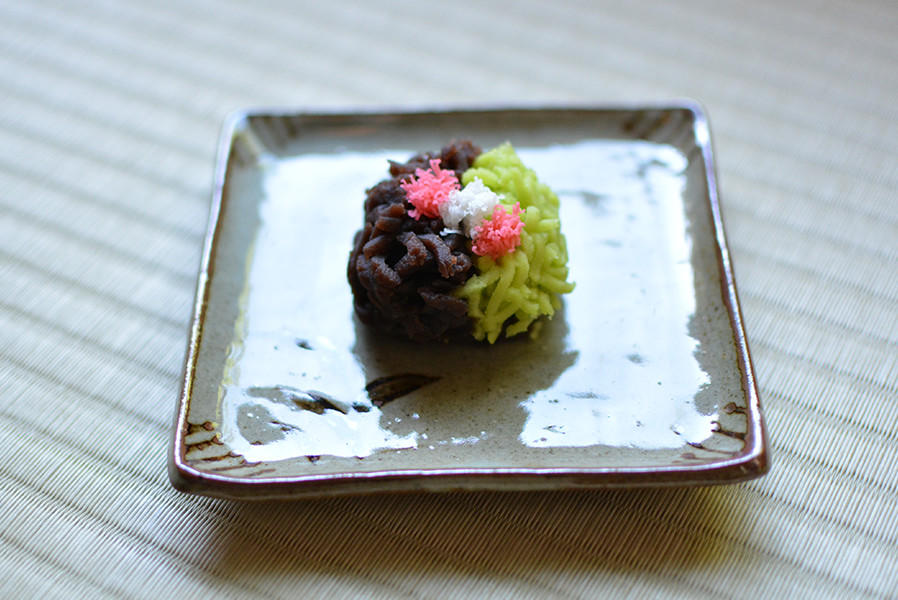
Iwane Tsutsuji (Iwane Azalea)
A popular confection from back in the Edo period. It is made of minced sweet beans accented with the scent of white beans and brown sugar. A sweet to express the azalea flourishing wildly on the rocks, from late spring to early summer.
Designated Material : Japanese yam
Best-before period: 2 days
Haru no Hi (Spring Day)
Sweet baked beans wrapped in a steamed yam bun, designed to depict a butterfly elegantly dancing in the spring sunlight.
Designated Material : Japanese yam
Best-before period: 2 days

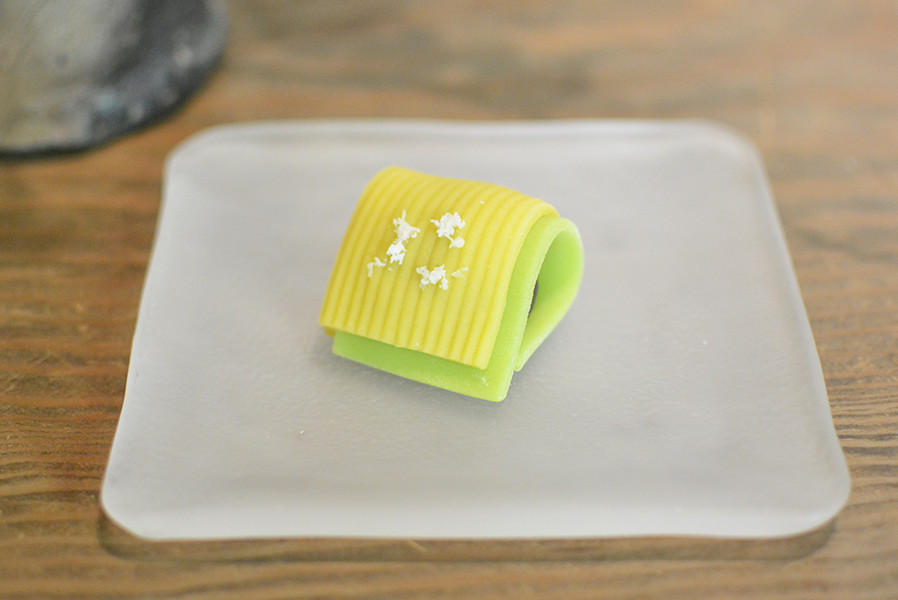
Ide no Se
Ide, located in Kyoto, was once the places to see yamabuki (Kerria Japonica) in the olden days. The two layers of mashed beans shaded in different colors, are wrapped in red bean paste, expressing the yamabuki glowing splendidly along the river.
Designated Material : Flour, Japanese yam
Best-before period: 2 days
Fujinami
Wisteria flowers blooming wild in the mountains. The view of the wisteria swaying in the wind is depicted by the combination of the sweet rice jelly and sweet bean jelly.
Designated Material : Flour
Best-before period: 2 days
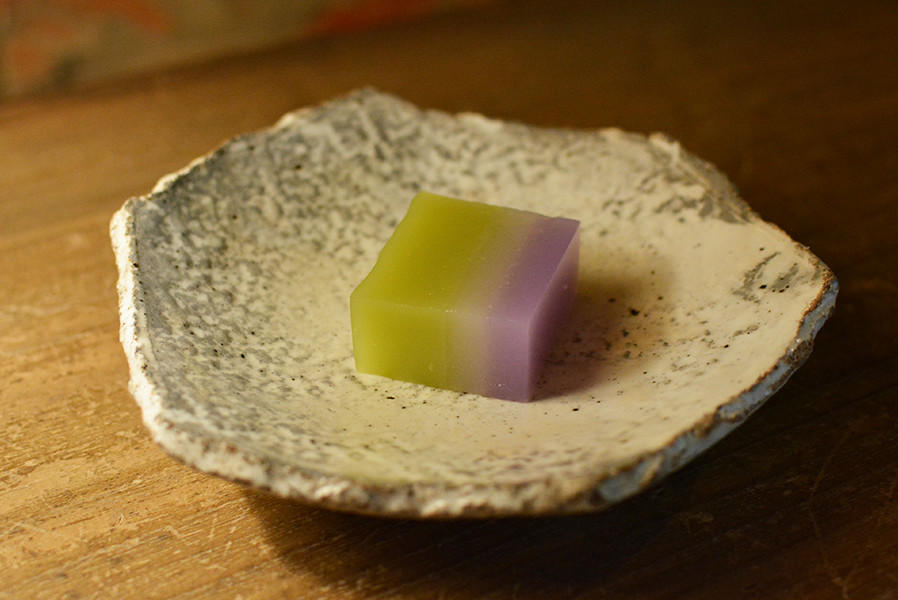
May
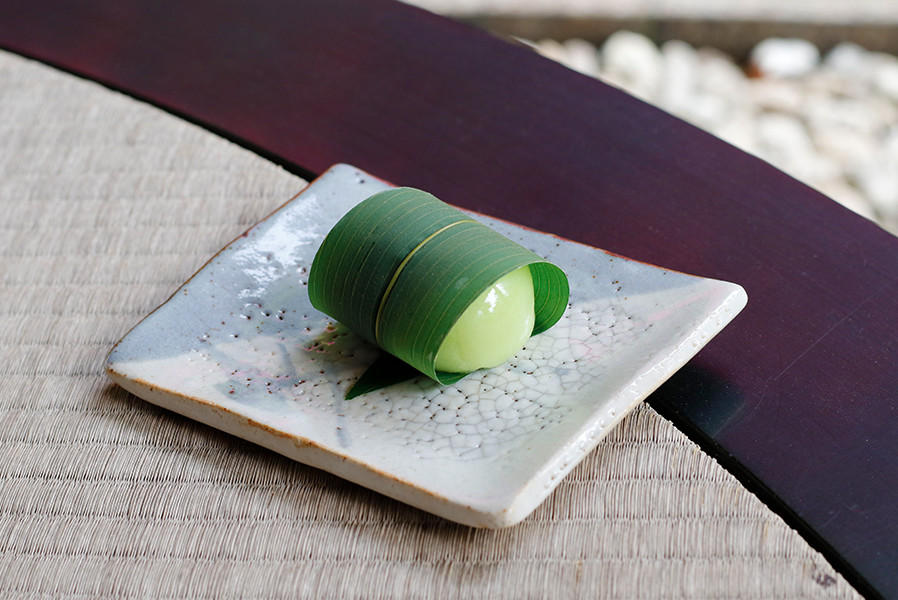
Sasamochi
It is prepared by mixing fine powder of Veitch's bamboo into white bean jam, and wrapping it with rice cake wafers. Enjoy the simplicity of the confection, and the bean paste with a rich scent of bamboo powder.
Designated Material : Eggs
Best-before period : 2 days
Shakunage (rhododendron)
Prepared with cooked sweet white beans and "konashi" (soft sweet baked bean paste, molded by hand). A confection depicting the beauty of rhododendron flourishing on the high mountains and valleys in early summer.
Designated Material : Japanese yam
Best-before period : 2 days


Karakoromo
Our original confection made of soft sweet bean paste, inspired by the poem "Kakitsubasa", included in the "Mikawa Yatsuhashi" series, written by Ariwara no Narihira.
Designated Material : Flour
Best-before period: 2 days
Yamashakuyaku (Mountain peony)
The "Yamashakuyaku", resembling the bloom of the small, white flowers, is ideal for evening tea. Using grated yam, we have created the lovely flowers of the mountain peony.
Designated Material : Japanese yam
Best-before period: 2 days
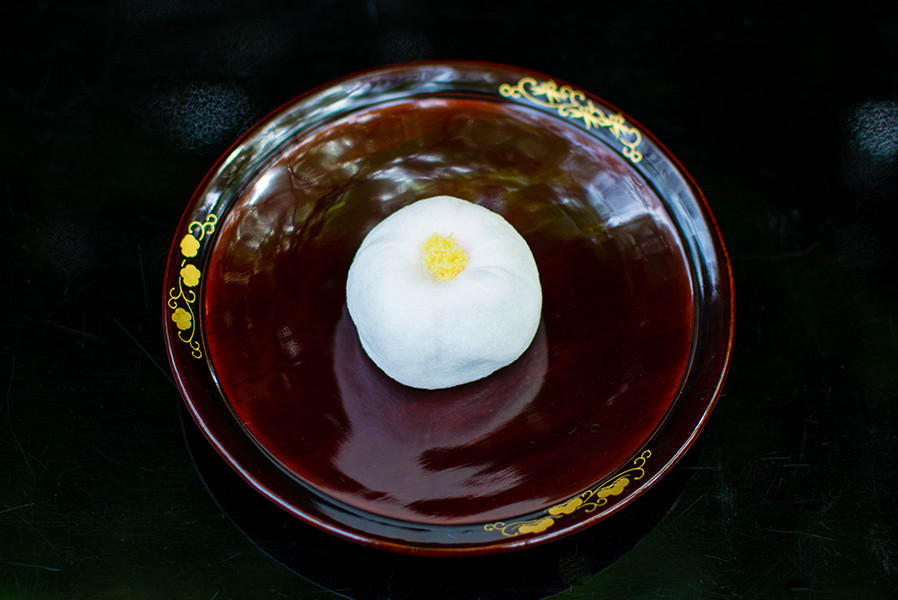
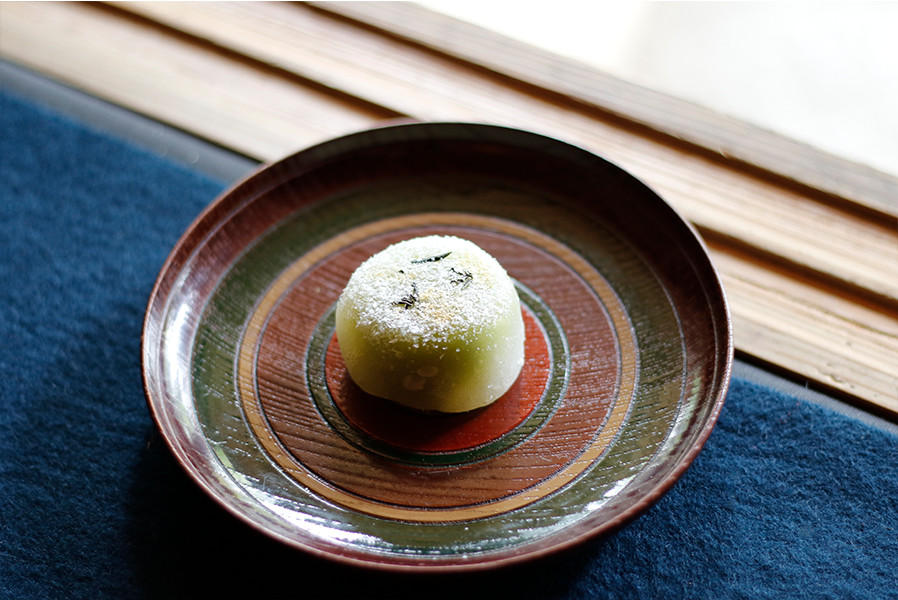
Chanoka
Looking into the beginning of summer through the arrival of the tea picking season. Made from bracken starch.
Best-before period: 2 days
Hanashoubu
Back in the old days, "菖蒲" (iris) and "尚武" (militarism) were linked with "勝負" (competition) through all having the same pronunciation, and this is considered perfect for the Boy's Festival on May 5th. It is made by wrapping red bean and white bean jam with "yoshino kuzu" (made of arrowroot from Yoshino, Nara).
Best-before period: 2 days
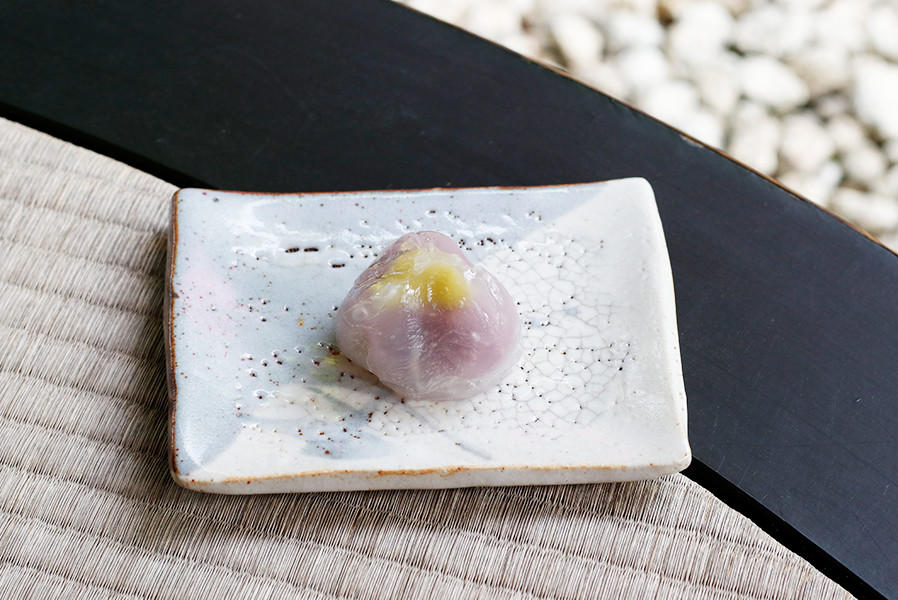

Miyamakirishima
Mountain azalea, blooming wild. Covering a ball of cooked sweet bean with minced bean paste depicts the beauty of the flourishing azaleas.
Designated Material : Japanese yam
Best-before period: 2 days
Yashio
New maple leaves, sprouting with a red tint in spring. This confection resembles "Yashio", a fabric dyed over and over to get the deep red color.
Designated Material : Flour
Best-before period: 2 days


Yatsuhashi
Yatsuhashi, located in Mikawa Province as recorded in the "Tales of Ise" is well know for its rabbitear iris. It is very similar to other irises, with rich purple petals. A sweet bean paste rolled in "karukan" (steamed bun made of grated yam).
Designated Material : Japanese Yam
Best-before period: 2 days
Shinjyu
The vibrant green of the leaves in early summer. It is prepared by wrapping white bean jam with "neri-yokan" (Sweet bean jelly) and "uirou" (sweet rice jelly).
Designated Material : Flour
Best-before period: 2 days
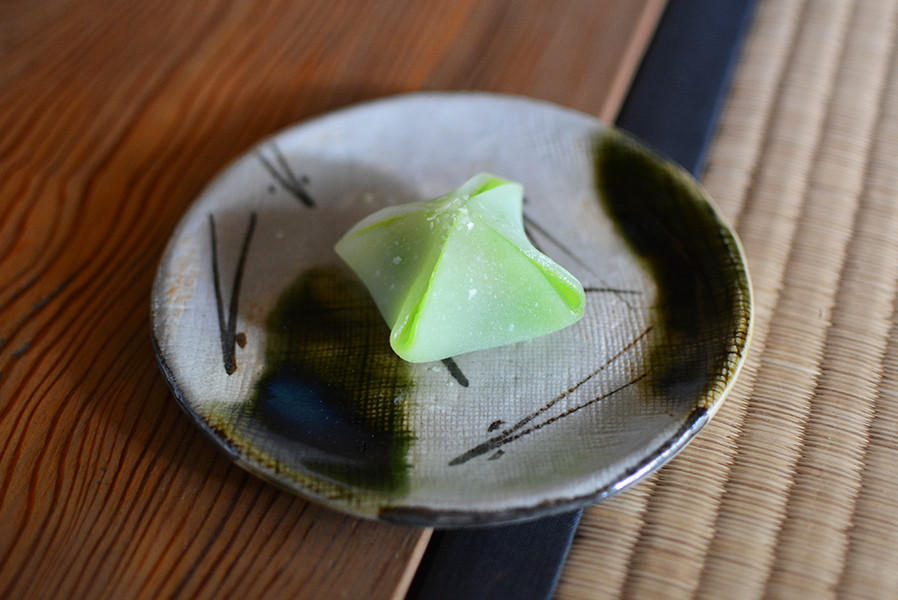
June

“Nuretsubame” (Wet Swallow in the Rain)
Details: The confection named “Nuretsubame” is prepared by using “Uiro” (sweetened steamed cake made of rice powder) printed with a pattern of swallow carrying food while flying low in the rain as a familiar scenery around the rainy season in Japan.
“Kagaribi”
Details : “Kagaribi” (bonfire) at the bow of “Ubune” (boat used for cormorant fishing), lighting up the river surface is a special feature of summer event at night time. The confection named “Kagaribi” is prepared by wrapping strained sweet adzuki bean paste with sheet of Yoshino kudzu colored in light red.
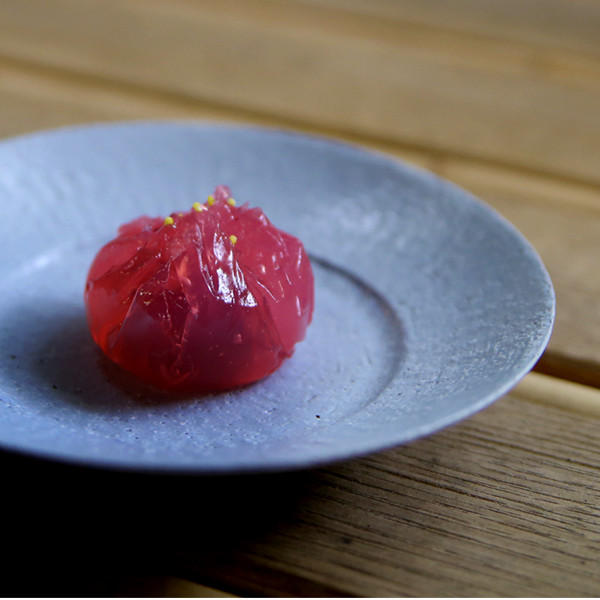
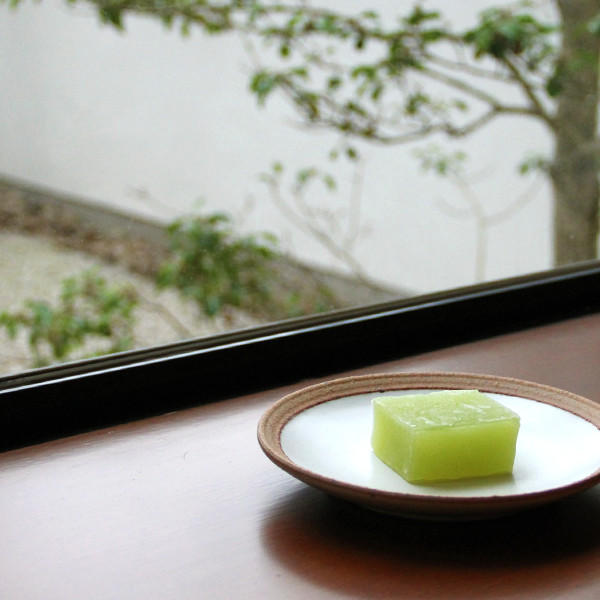
“Kudzuyaki” (Toasted Kudzu Cake)
Details : The confection named “Kudzuyaki” is originated from sweets served at a tea ceremony in Muromachi Period. Surfaces of Yoshino kudzu cake with quality texture are lightly toasted, giving you delight in its flavor and light taste.
“Nadeshiko no Hana” (Dianthus)
Details : The flower named ”Nadeshiko” (dianthus) often resembles Japanese woman with gentle and sweet disposition. The confection “Nadeshiko no Hana” named after such flower is made of “Konashi” (prepared by kneading mixture of strained sweet bean paste, flour, and sugar).
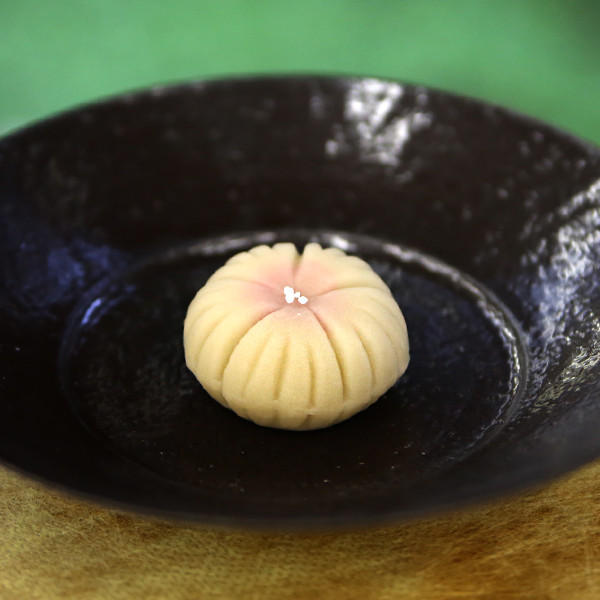
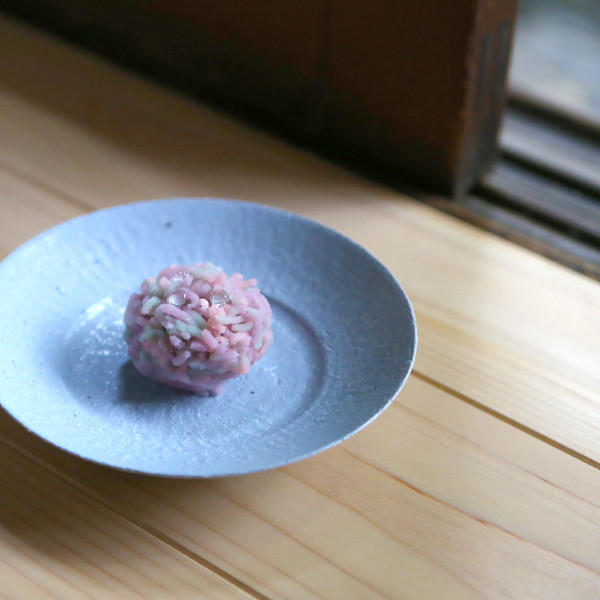
“Ajisai no Tsuyu” (Dews on Hydrangea)
Details : Hydrangea varies its color day by day. The confection named “Ajisai no Tsuyu” (Dews on Hydrangea) is designed to express the hydrangea having dews, prepared by putting gleaming jellies on a “Kinton” (mashed ball of strained sweet white adzuki bean paste).
“Sawabe” (Edge of Stream)
Details : The confection named “Sawabe” is designed to express typical scenery in summer season having plants growing abundantly around the edge of stream.
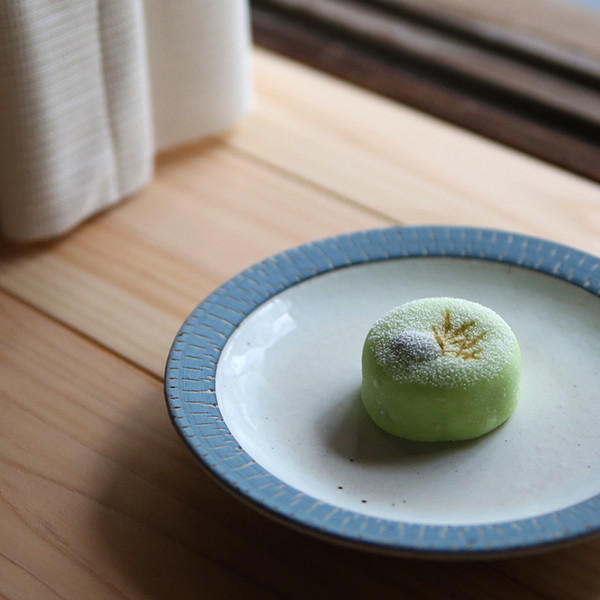
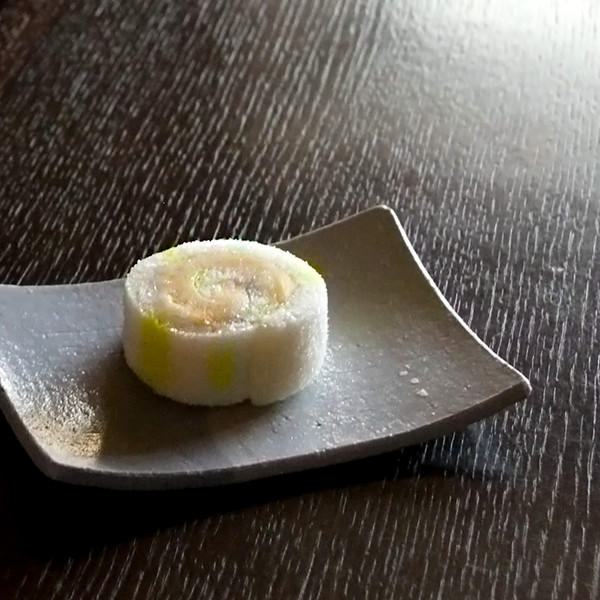
“Minamo” (Water surface)
Details : The confection named “Minamo” is designed to express rings on the water reflecting sunbeams shining through branches of trees, prepared by wrapping with “Karukan” (steamed sweet bun made from grated yam and rice flour), giving an impression of cool breeze across the water surface.
“Biwa no Mi” (Loquat Fruit)
Details : In the rainy season, loquat fruits beautifully color the garden, giving off a sweet scent. The confection named “Biwa no Mi” is shaped like the loquat fruit, prepared by wrapping sweet strained white adzuki bean paste with “Uiro” (sweetened steamed cake made of rice powder).
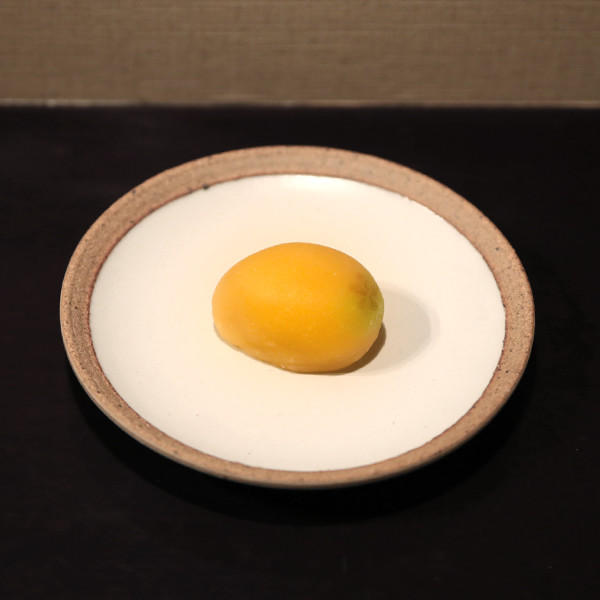
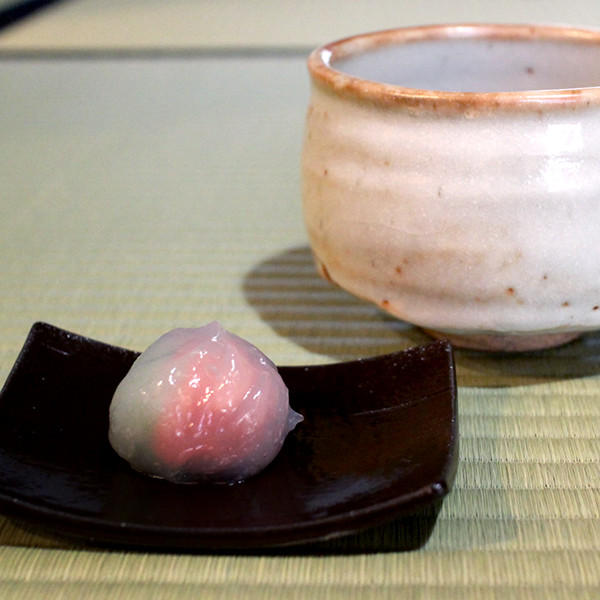
Ajisai
Details: Ajisai (Hydrangea) exhibits the greatest beauty when it is wet with rain. The confection named Ajisai is prepared by using tri-colored strained sweet bean paste wrapped with kudzu sheet.
“Yubotaru” (Firefly in the Evening)
Details : The confection named “Yubotaru” is prepared by sprinkling jellies on “Kinton” (mashed ball of sweet paste covered with minced sweet paste) as a reminder of old days of catching firefly while listening to the sound of a stream.
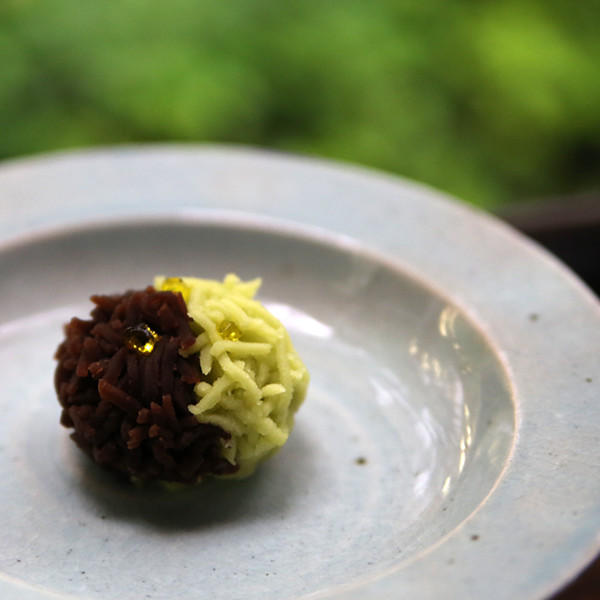
July
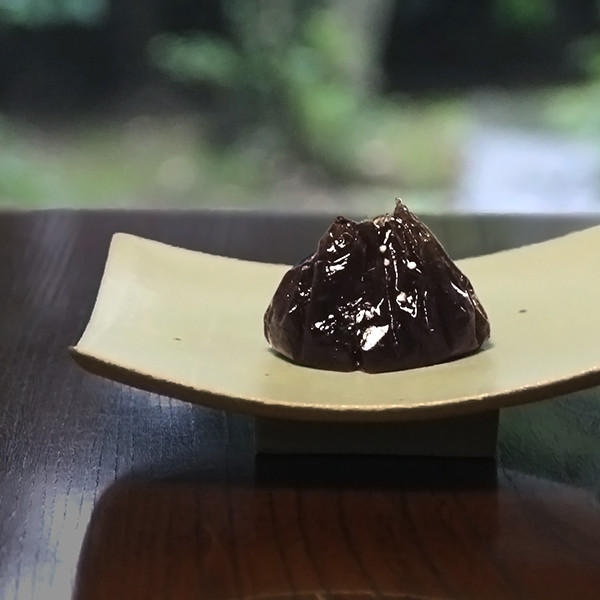
“Araiso” (Rough Shoreline)
Details : “Araiso” is a confection called “Kudzu-shibori”, hand-twisted Kudzu (arrowroot gel) cake, making good use of the flavor and aroma of “Kokuto” (brown sugar or muscovado) produced in Okinawa. “Araiso” is designed to express the dark rock on the rough shoreline with splash of restless stormy waves.
Best-before Period : 2 days
“Kudzuyaki” (Toasted Kudzu Cake)
Details : “Kudzuyaki” is originated from sweets served at a tea ceremony in Muromachi Period. Surfaces of cake of quality “Yoshino kudzu” (made of arrowroot produced in Yoshino, Nara) are lightly toasted, giving the delight in its flavor and light taste.
Designated Material : “Soybeans”
Best-before Period : 2 days
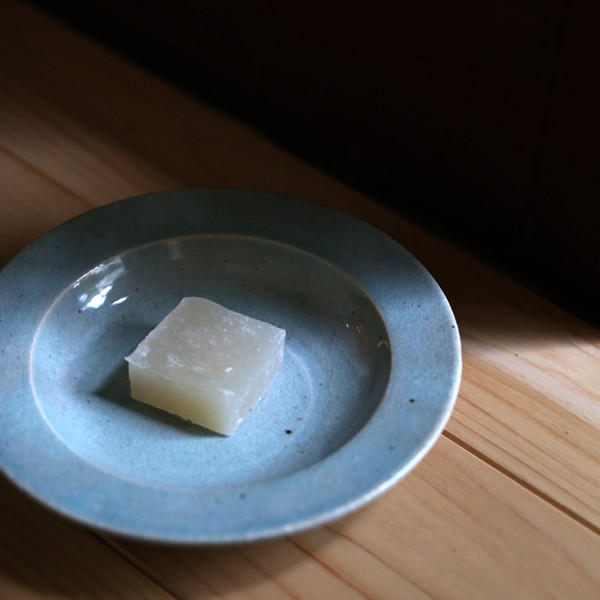

“Suichuka” (Underwater Flower)
Details : Underwater flower is the artificial flower set in the cup filled with water as a familiar item for sale on the night market at summer festival. Unfolded petals of the underwater flower gently trembles, exhibiting magically romantic charm. “Suichuka” is prepared by wrapping white adzuki bean paste with “Kingyoku-kan” (colored agar gel).
Best-before Period : 2 days
“Asagao” (Morning-glory )
Details : The flower ”Asagao” (morning-glory) blooms with dews at break of dawn, and soon fades before the dew dries up, showing transient beauty. “Asagao” is prepared by wrapping strained sweet adzuki bean paste with “Uiro” (sweetened steamed cake made of rice powder) printed with picture of the morning-glory.
Designated Material : “Flour”
Best-before Period : 2 days
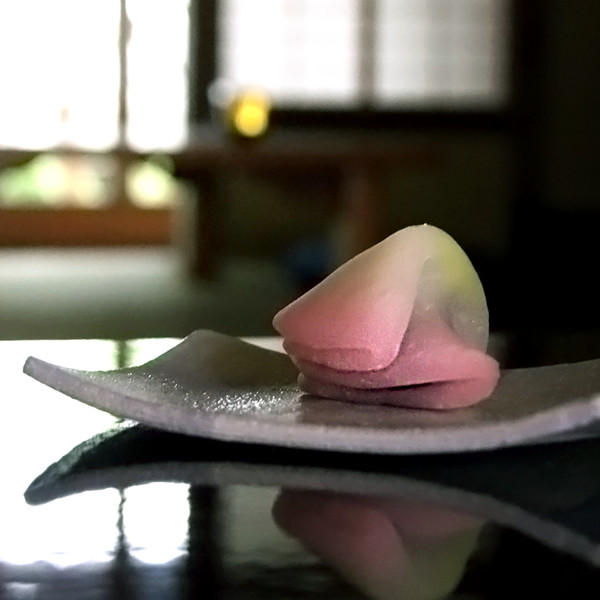
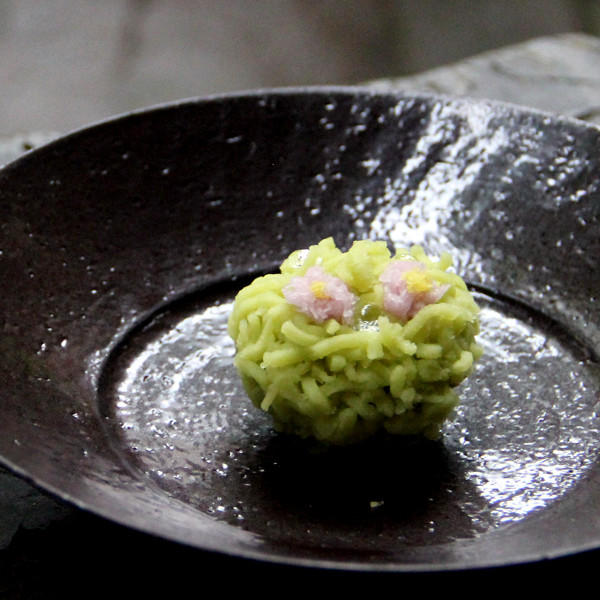
“Tsuyu-suzushi” (Cool Dew)
Details : Early in the summer morning, wild plants in the fields bloom with dews, awakening a cool sensation. “Tsuyu-suzushi” is prepared by sprinkling minced “Kingyoku-kan” (colored agar gel) on “Kinton” (sweet bean-paste ball covered with small pieces of strained sweet adzuki paste).
Best-before Period : 2 days
“Araiso” (Rough Shoreline)
Details : “Araiso” is a confection called “Kudzu-shibori”, hand-twisted Kudzu (arrowroot gel) cake, making good use of the flavor and aroma of “Kokuto” (brown sugar or muscovado) produced in Okinawa. “Araiso” is designed to express the dark rock on the rough shoreline with splash of restless stormy waves.
Best-before Period : 2 days
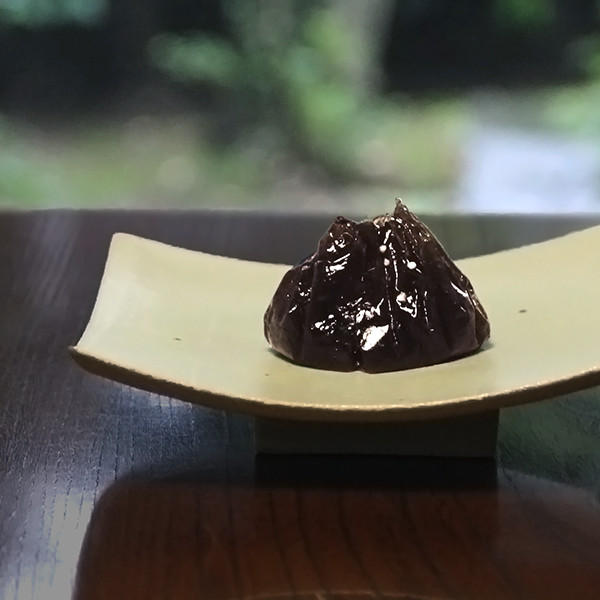

“Yoi-matsuri” (Night festival)
Details : Night festival featuring “Dashi” (festival float) beautifully decorated with lanterns, and paper fans is one of the summer sceneries throughout Japan. “Yoi-matsuri” is a rice cake printed with a Chinese character that means “festival”.
Designated Material : “Egg”
Best-before Period : 2 days
“Kudzu-manju” (Clear kudzu cake stuffed with sweet adzuki bean paste)
“Kudzu-manju” is prepared by wrapping Yoshino kudzu (arrowroot produced in Yoshino, Nara) cake stuffed with strained sweet adzuki bean paste with a bamboo leaf. Thanks to clear and cool texture, “kudzu-manju” is a typical refreshment for the summer season, awakening a cool sensation.
Best-before Period : 2 days
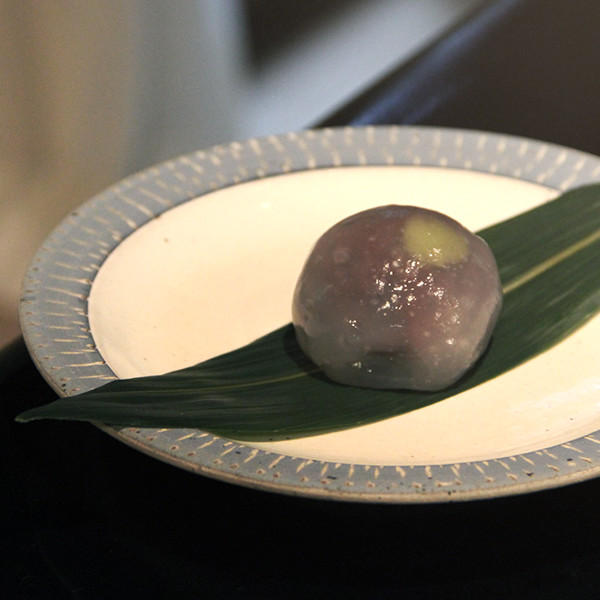
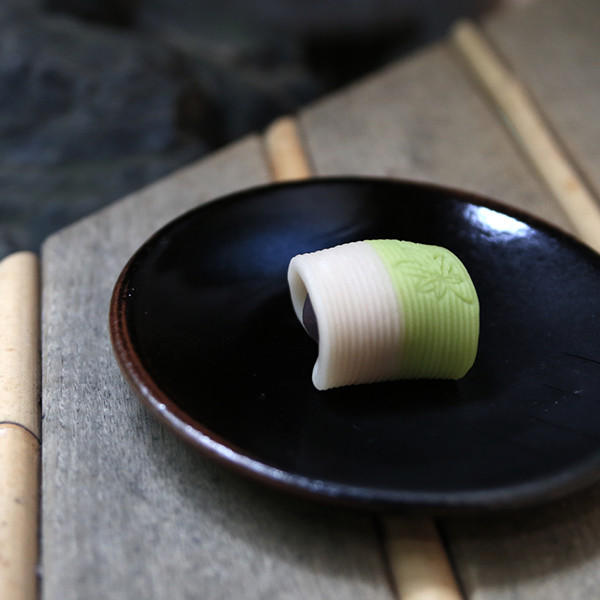
“Ao-kaede” (Green Maple Leaf)
Details : A bi-colored “Konashi” (kneaded mixture of strained sweet bean paste, flour, and sugar) is designed to set off the green color of maple leaf, which is made far brighter as the heat becomes more severe in the summer season.
Designated Material : “Flour”
Best-before Period : 2 days
“Seseragi” (Sound of stream)
Details : Using “Awayuki-kan” (meringue jellified with agar) and “Kingyoku-kan” (agar gel) for expressing coolness inspired from the sound of flowing water of the stream, reflecting sunbeams shining through branches of trees.
Designated Material : “Egg”
Best-before Period : 2 days
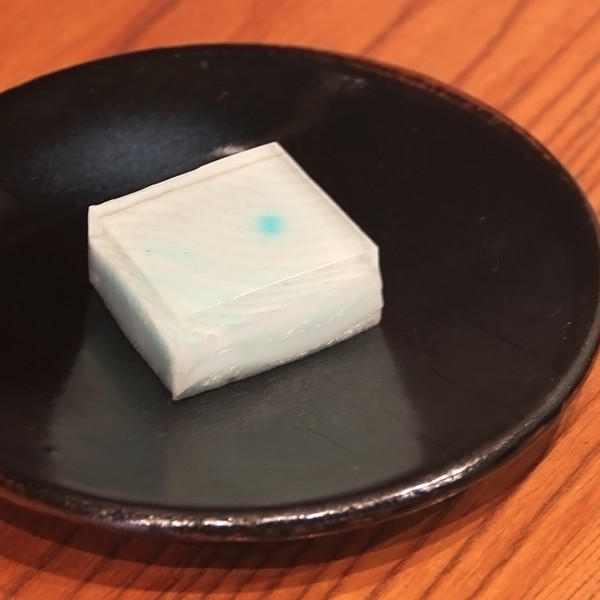
August
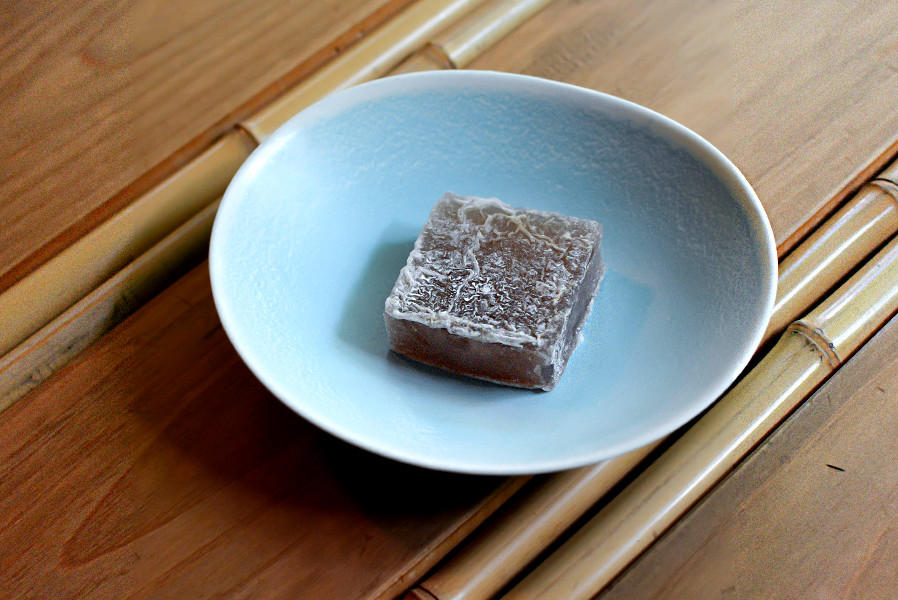
“Kudzuyaki - Agari” (Toasted Kudzu Cake - Tea)
Details : “Kudzuyaki” is originated from sweets served at a tea ceremony in Muromachi Period. This confection is prepared by kneading strained sweet adzuki bean paste with quality “Yoshino kudzu” (made of arrowroot produced in Yoshino, Nara), giving the delight in its delicate flavor and light taste.
Designated Material : “Soybeans”
Best-before Period : 2 days
“Araiso” (Rough Shoreline)
Details : “Araiso” is a confection called “Kudzu-shibori”, hand-twisted Kudzu (arrowroot gel) cake, making good use of the flavor and aroma of “Kokuto” (brown sugar or muscovado) produced in Okinawa. “Araiso” is designed to express the dark rock on the rough shoreline with splash of restless stormy waves.
Best-before Period : 2 days

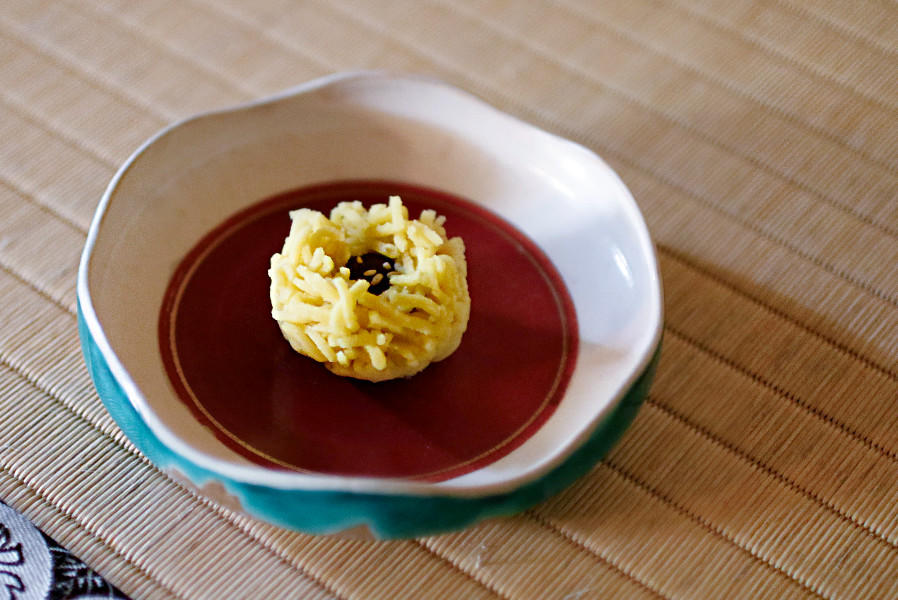
“Sunflower”
Details : In midsummer, sunflower has a large flower in bloom with its stem extending lustily. This confection is prepared by wrapping strained sweet adzuki bean paste with “Kinton” (mashed sweet bean paste).
Designated Material : “Sesame seeds”
Best-before Period : 2 days
“Iwashimizu” (clear water that springs out between rocks)
Details : “Iwashimizu” denotes the clear water glinting like jewel, flowing from mountain areas. Putting hands into the water, everyone may feel like being purified both physically and spiritually. This confection is a jellified agar stuffed with “Gyuhi” (rice cake made from glutinous rice flour) and “Dainagon Adzuki bean” (large-grained adzuki bean) paste for expressing the limpid scenery.
Best-before Period : 2 days
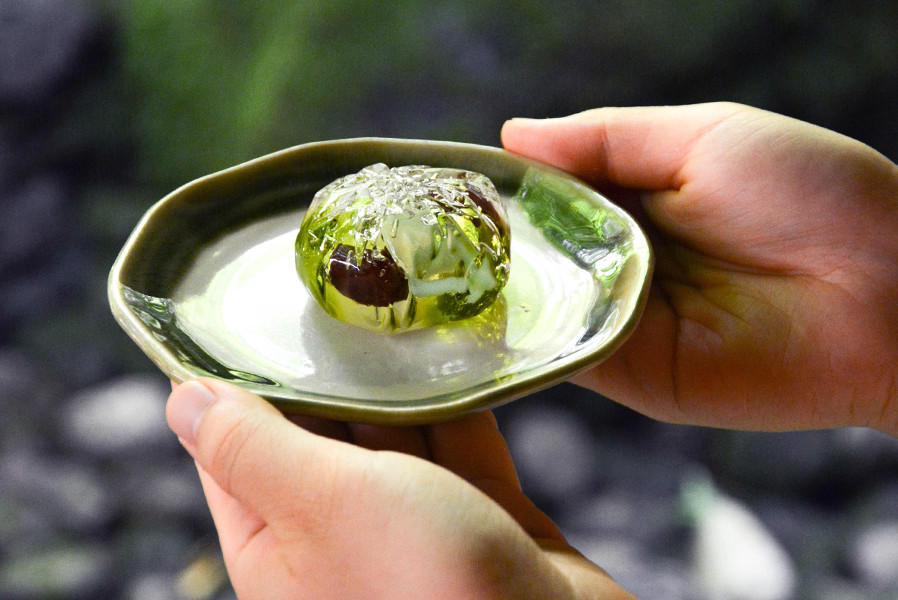
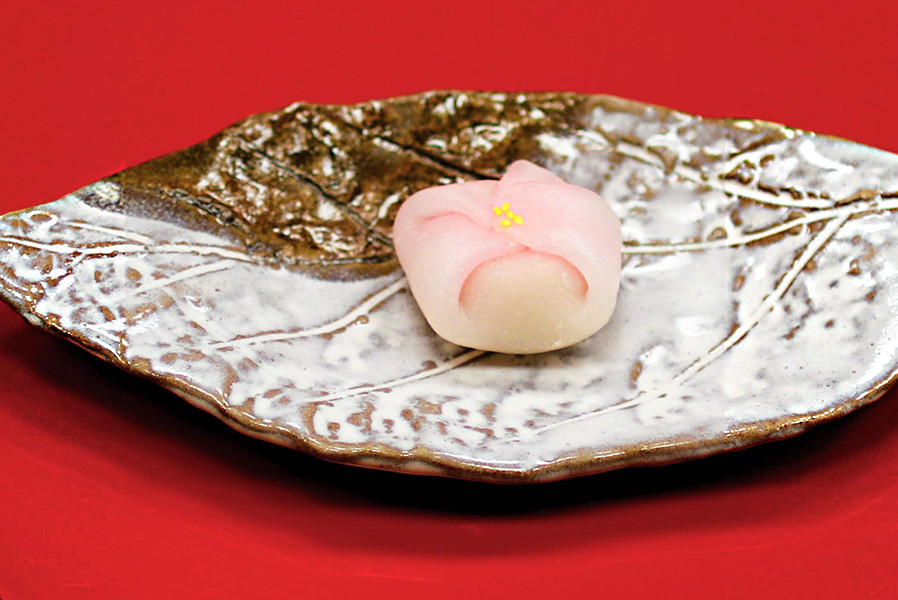
“Suifuyo” (Chinese hibiscus)
Details : The pale rose-colored flower named “Suifuyo” in bloom will gradually turn red, and soon wither in the end of the day. This confection is made as a sweetened steamed rice cake for expressing the transient beauty of the flower.
Designated Material : “Flour”
Best-before Period : 2 days
“Kudzu-manju” (Ball of bean paste covered with kudzu starch)
Details : “Kudzu-manju” is a simply shaped confection prepared by using Yoshino-kudzu (arrowroot produced in Yoshino, Nara) cake kneaded with Do-myo-ji powder (dried and granulated glutinous rice flour), which is then stuffed with strained sweet adzuki bean paste, and further wrapped with a bamboo leaf.
Designated Material : “Flour”
Best-before Period : 2 days
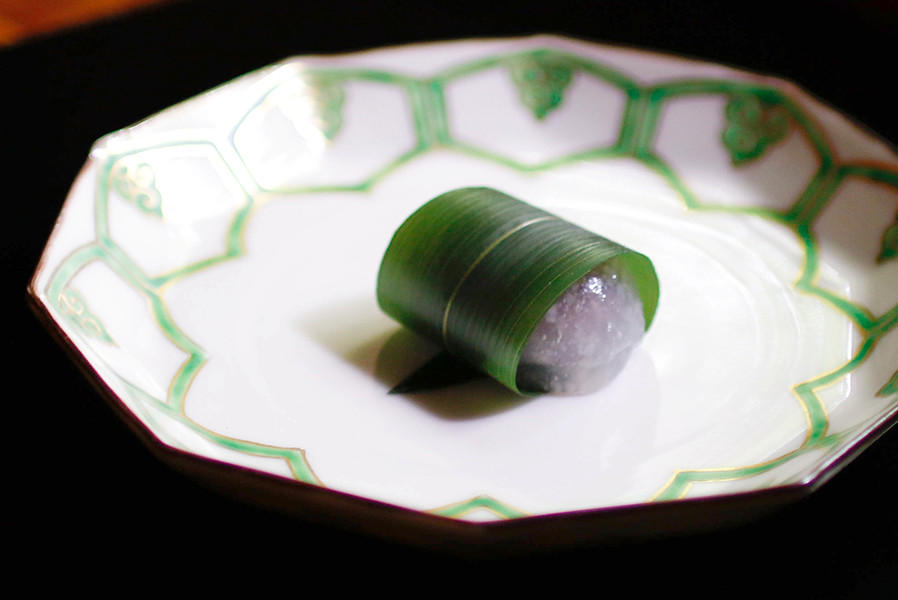

“Hagi no Tsuyu” (Dew on Bush Clover)
Details : “Hagi”, bush clover as a symbol for autumn is expressed in a single Chinese character composed of two Chinese characters indicating “grass” and “autumn”. In early autumn, “Hagi” has pretty little flowers in bloom with dews, reflecting the upcoming autumn. “Hagi no Tsuyu” is a confection prepared by covering a ball of strained sweet white adzuki bean paste with small pieces of jellified agar just like the dew.
Best-before Period : 2 days
“Yoi-no-Tsuki” (Moon in the twilight hours)
Details : “Yoi-no-Tsuki” is a confection of Kudzu cake (made of kudzu starch) flavored with Kokuto (muscovado), which is stuffed with yellow-dyed strained sweet white adzuki bean paste for expressing autumn moon as the most beautiful scenery of the year.
Best-before Period : 2 days
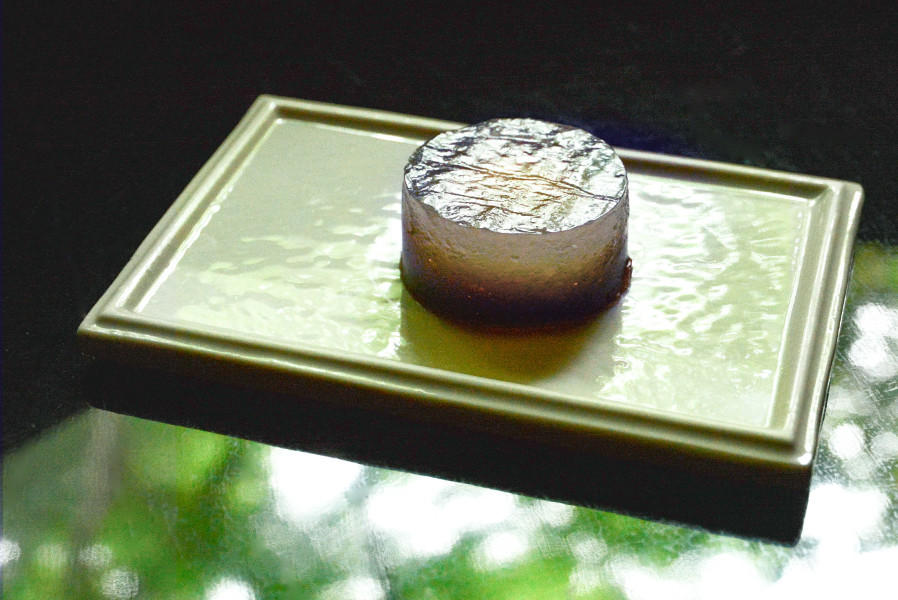
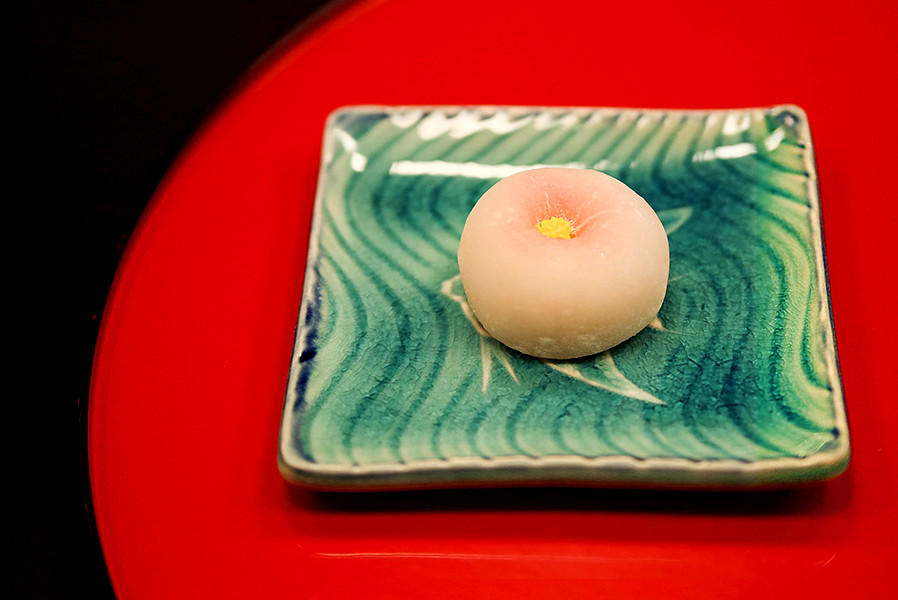
“Hana-Fuyo” (Cotton Rose)
Details: “Hana-Fuyo” (Cotton Rose) in bloom with morning dew is often called “Queen of autumn flower” because of its elegance and sensitive beauty. This confection is prepared by wrapping a ball of strained sweet white adzuki bean paste with “Uiro” for expressing the refined taste.
Best-before Period : 2 days
“Akitsu” (Dragonfly)
Details : Red-colored dragonflies on the wing in red sky of the evening glow reflect the arrival of autumn as well as clear air and cool breeze in morning and evening. “Akitsu” is a roll of strained sweet white adzuki bean paste wrapped in “Karukan” (steamed sweet bun).
Designated Material : “Japanese yam”
Best-before Period : 2 days
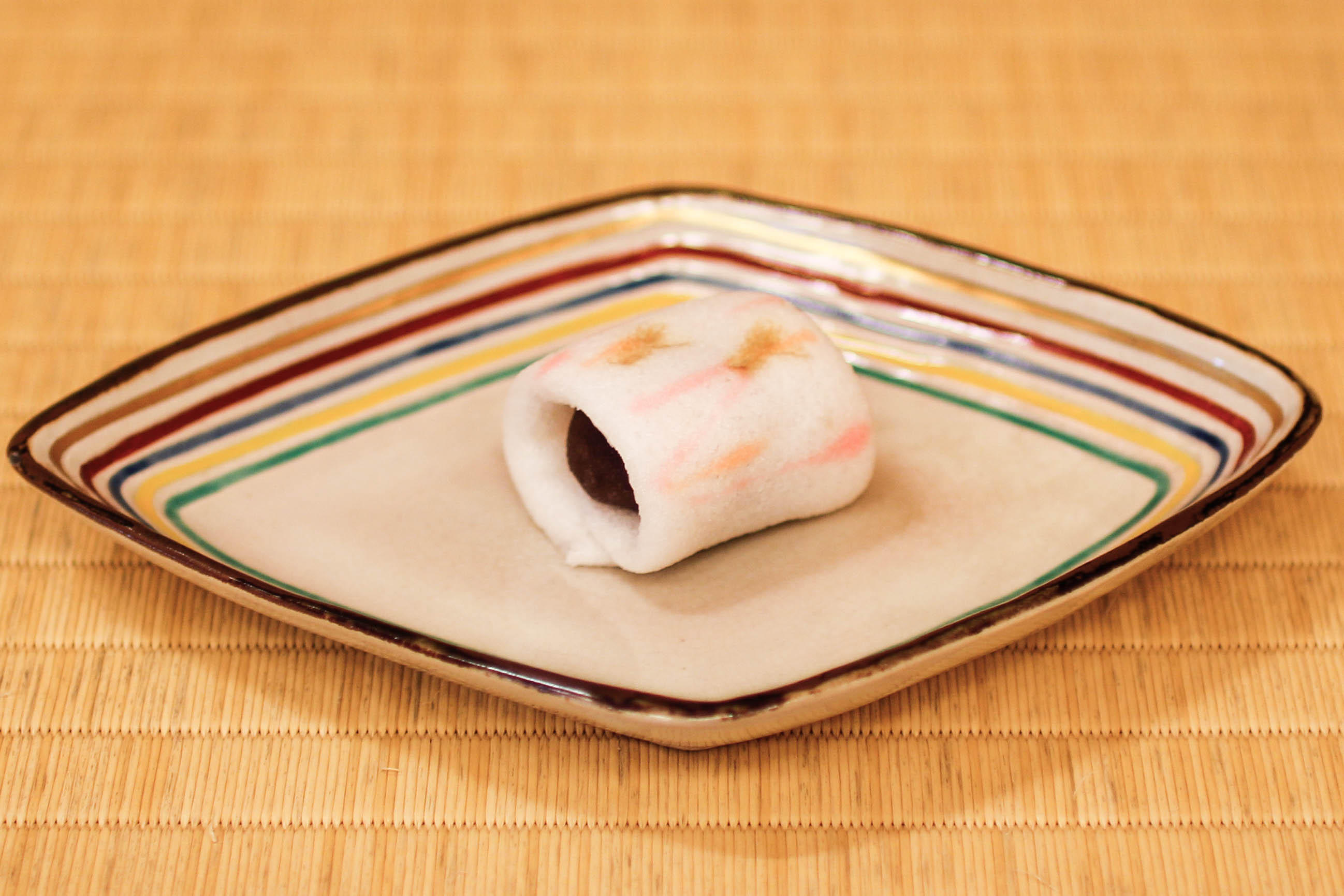
September
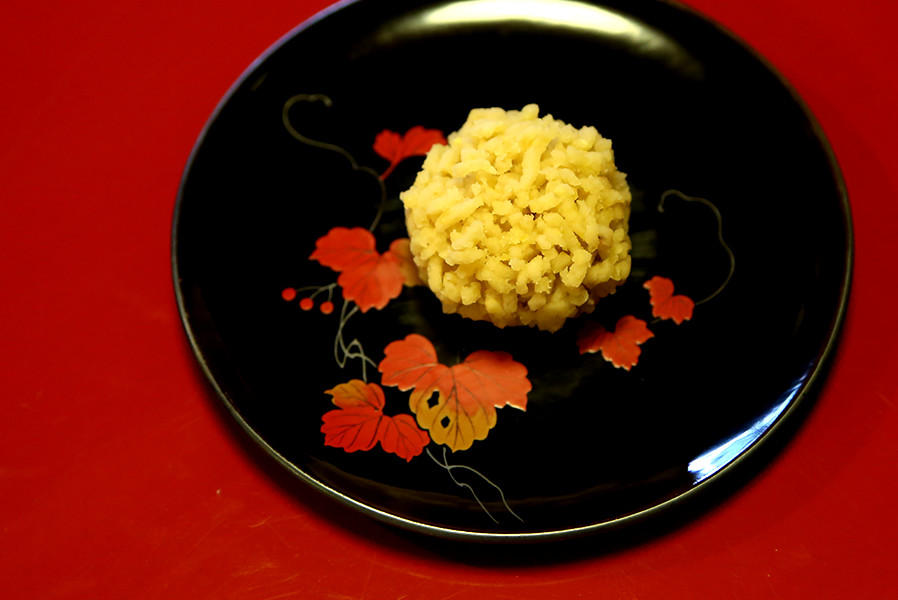
"Kuri-kinton" (Small bun made from mashed sweet chestnut paste)
Details : This confection is prepared by covering a small ball of strained sweet adzuki bean paste with minced paste of fresh chestnut, which is our highly recommended taste of autumn.
Best-before Period : 2 days
“Emi-guri” (Ripened chestnut suggestive of smiling face)
Details : Autumn frost accelerates ripening of chestnut that will soon drop out from burst opened burr. This confection, as a typical taste of autumn, is prepared by wrapping a ball of strained sweet adzuki bean paste mixed with chestnut with thin wafers made from rice cake.
Designated Material : “Egg”, “Japanese yam”
Best-before Period : 2 days


“Kise-wata” (Chrysanthemum covered with silk floss)
Details : In old days in Japan, on the Choyo Festival or the Chrysanthemum Festival (September 9) , praying for longevity, people had the custom of cleansing their bodies with wet silk floss that had been covered on chrysanthemums to draw up the evening dew prior to the day of the Festival. This confection is prepared by putting minced paste of sweet Japanese yam on the kneaded mixture of strained sweet bean paste, flour and sugar, shaped as a chrysanthemum.
Designated Material : “Flour”, “Japanese yam”
Best-before Period : 2 days
“Honami” (Rice plants waving in the winds)
Details: The typical Japanese scenery in early autumn is golden rice field rich in harvest with swaying rice plants in the breeze. This confection is prepared by combining “Karukan” (steamed sweet bun made from grated yam and rice flour) with “Mushi-yokan” (steamed sweet adzuki-bean jelly) for expressing the rice plants waving in the winds.
Designated Material : “Flour”, “Japanese yam”
Best-before Period : 2 days

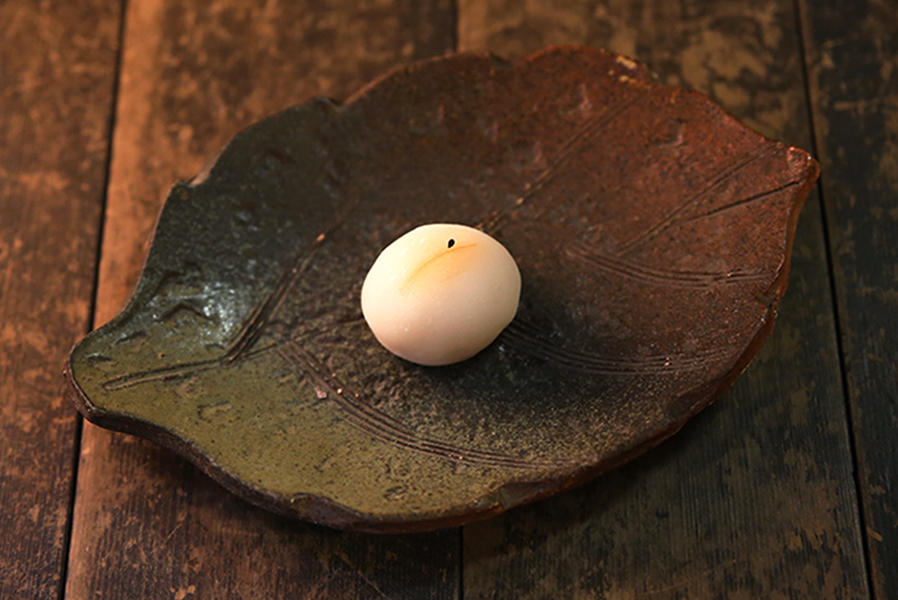
“Aki-no-ne” (Sound of autumn)
Details : Clear air, chirping of insect, and sound of wind in the trees reflect the approach of autumn in Japan. This confection is prepared by wrapping a ball of strained sweet white adzuki bean paste with sweetened steamed rice cake. A black sesame seed is put on the top surface to resemble the insect.
Designated Material : “Sesame seeds”
Best-before Period : 2 days
"Kuri-kinton" (Small bun made from mashed sweet chestnut paste)
Details : A small ball of strained sweet adzuki bean paste is covered with minced fresh chestnut paste. This is our highly recommended taste of autumn.
Best-before Period : 2 days
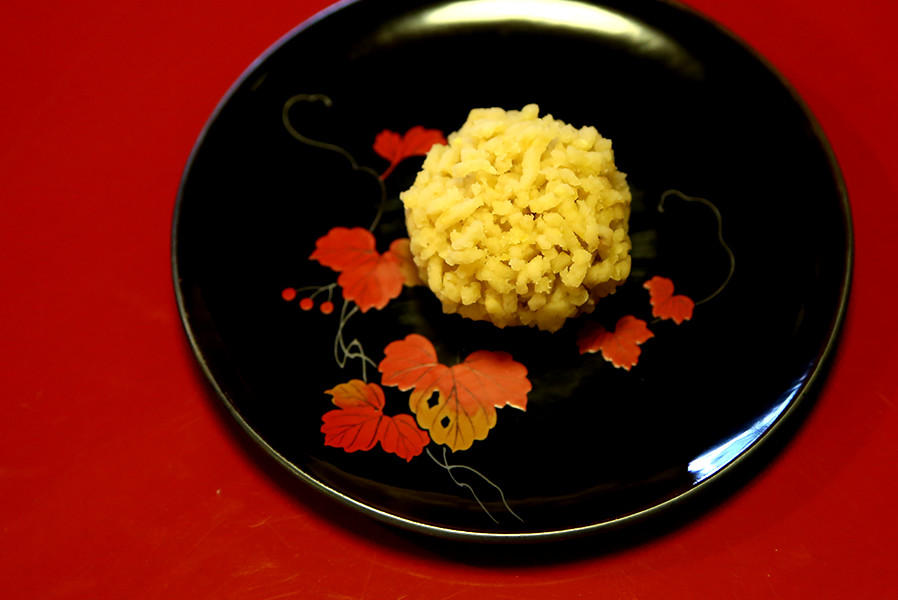
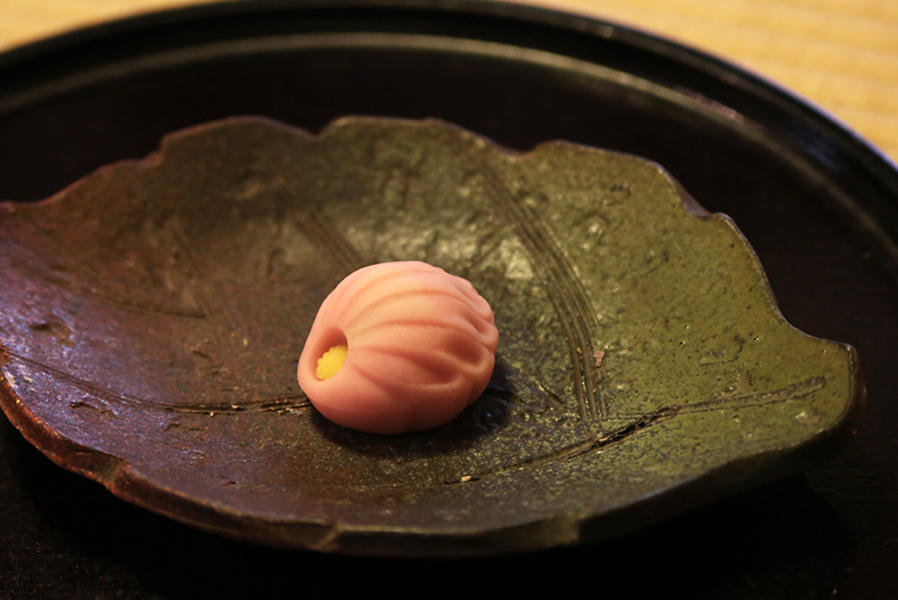
“Manju-giku” (Marigold)
Details : Around the season of the “Choyo Festival”, people can enjoy viewing many varieties of chrysanthemum in full bloom for a long period of time.
This confection is prepared by kneading mixture of strained sweet bean paste, flour and sugar, shaped into the specific type of chrysanthemum called “Manju-Giku” (marigold), which is generally believed as the symbol of longevity.
Designated Material : “Flour”
Best-before Period : 2 days
Kobore-Hagi
Details: In early autumn, the plant called Hagi (bush clover) will blossom with pretty little flowers in long spike until its shedding in mid-autumn. This confection is prepared by wrapping the strained sweet white adzuki bean paste with Uiro (sweetened steamed rice cake) for expressing the appealing taste of shedding toward the end of autumn.
Best-before Period : 2 days
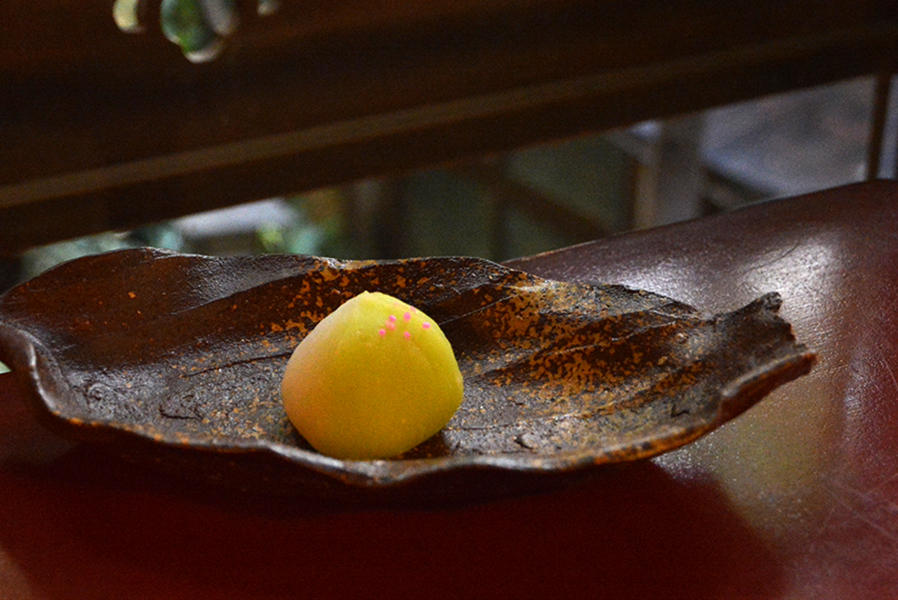
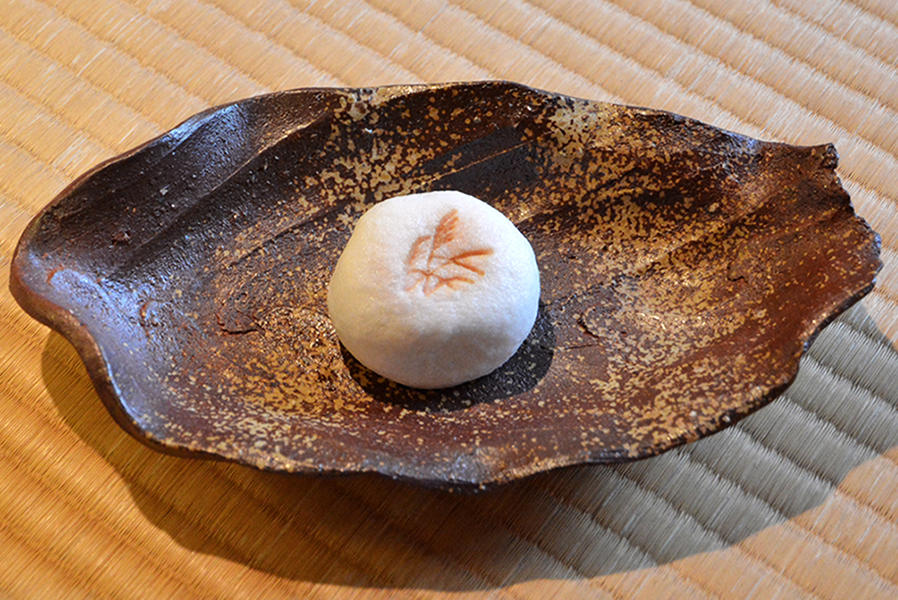
Musashino
Details: Musashino is the place in Japan famous for its beautiful scenery of wild autumn plants and moon from old times. This confection is prepared by branding a mark of pampas grass on a steamed yam bun stuffed with strained sweet adzuki bean paste.
Designated Material : “Japanese yam”
Best-before Period : 2 days
Akikusa
Details: There are great variety of plants which turn beautiful colors along with deepening of autumn. This confection is prepared by wrapping strained sweet adzuki bean paste and chestnut with bracken-root starch.
Best-before Period : 2 days

October
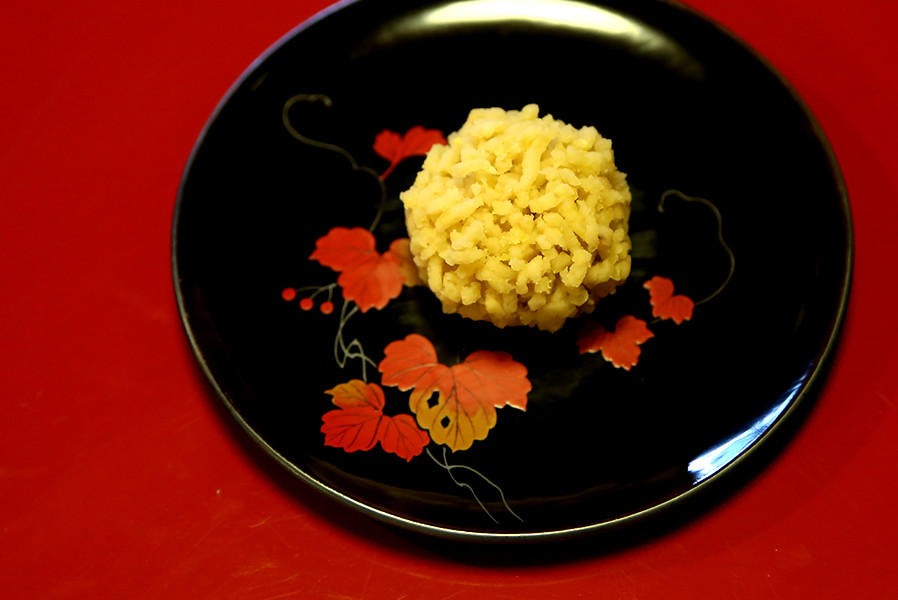
Kuri-kinton
Details: Softly ground chestnut paste frosting a smoothly rounded minched-sweetbean, sending a scent of Autumn to Ryouguchi-ya Korekiyo.
Best-before Period : 2 days
Miyama no Aki
Details: A spice of raw sugar seasoning the rice cake wafers, coating the rounded baked sweet beans. Nerijyo-yoan, potato paste made of Jyo-yo potato, is richly shredded on top depicting the subtle hue of Autumn.
Designated Material: Japanese Yam
Best-before Period : 2 days
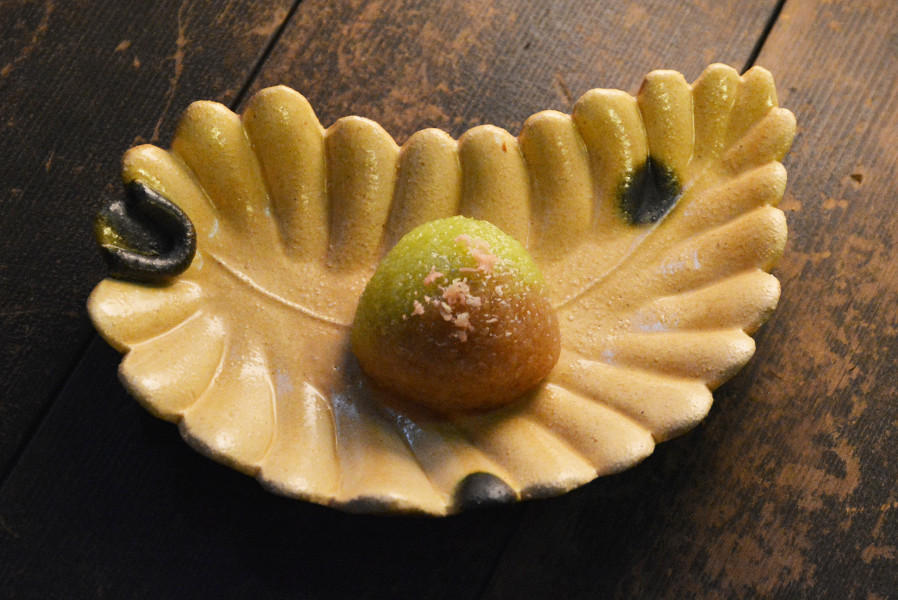

Kourinngiku
Details: A glorious painting of a chrysanthemum painted by Ogata Kourin, a famous artist back in the Genroku Period, is abstractedly depicted by Oribe-jyouyo, a traditional look of a white bun adorned with a vivid green ornament.
Designated Material: Flour, Japanese Jam, Soy bean
Best-before Period : 2 days
Rangiku
Details: Chrysanthemum flourishing like draped petals gracefully tousling wild. A ball of smooth sweet beans layered by Konashi, manners of shaping pastes in beautiful figures.
Designated Material: Flour
Best-before Period : 2 days

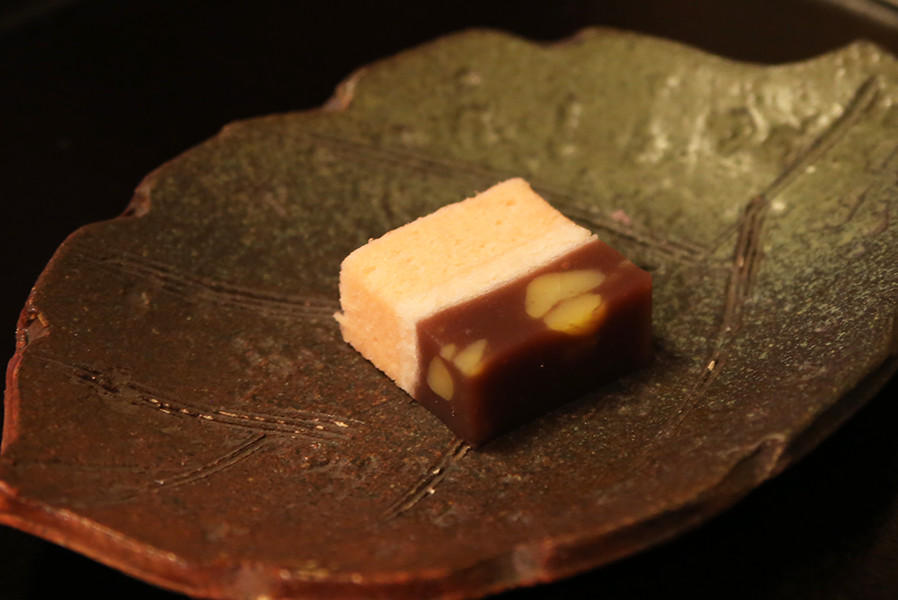
Yamaji no Nishiki
Details: Flaming leaves of Autumn flourish in the scenery. An exceptional montage of steamed sweet bun and sweet bean jelly.
Designated Material: Flour, Japanese Yam
Best-before Period: 2 days
Kuri-kinton
Details: Softly minched chestnut paste crusting the rounded sweet bean ball, with tastes of fresh chestnuts as signs of Autumn.
Best-before Period: 2 days
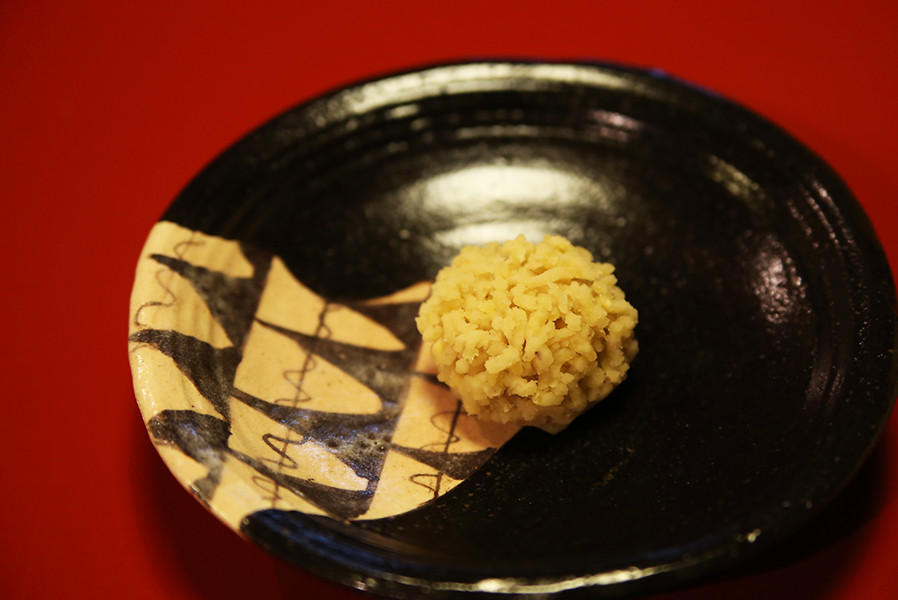
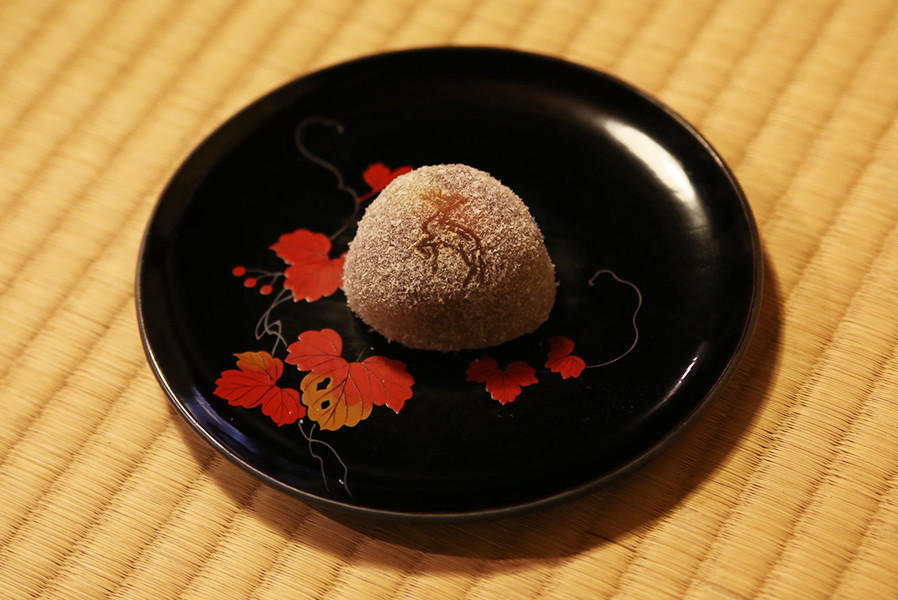
Sa-oshika
Details: Stags calling out for its beloved in the nostalgic mellow of Autumn, were often made into Japanese poets in the ancient days.
With bracken starch, the nostalgia is depicted on Sao-shika.
Best-before Period: 2 days
Kara-nishiki (Chinese Brocade)
Details: Karashouzoku, an ancient dress for proud moments in life is identical to the breath-taking beauty of the vivid Autumn. A ball of sweet bean paste cloacked by konashi, manners of shaping pastes in beautiful figures, is pressed into a form of Autumn leaf by a wooden patterer.
Designated Material: Flour
Best-before Period : 2 days
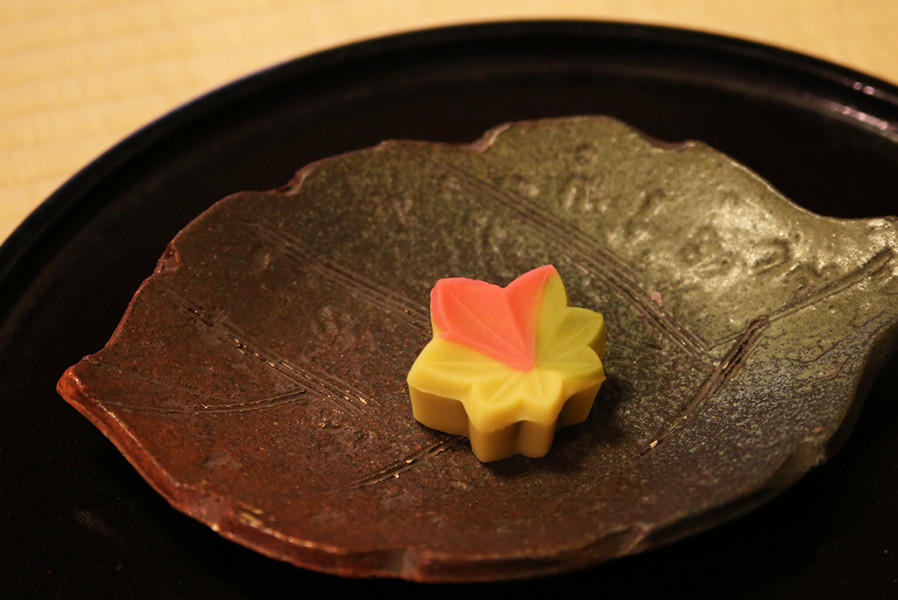
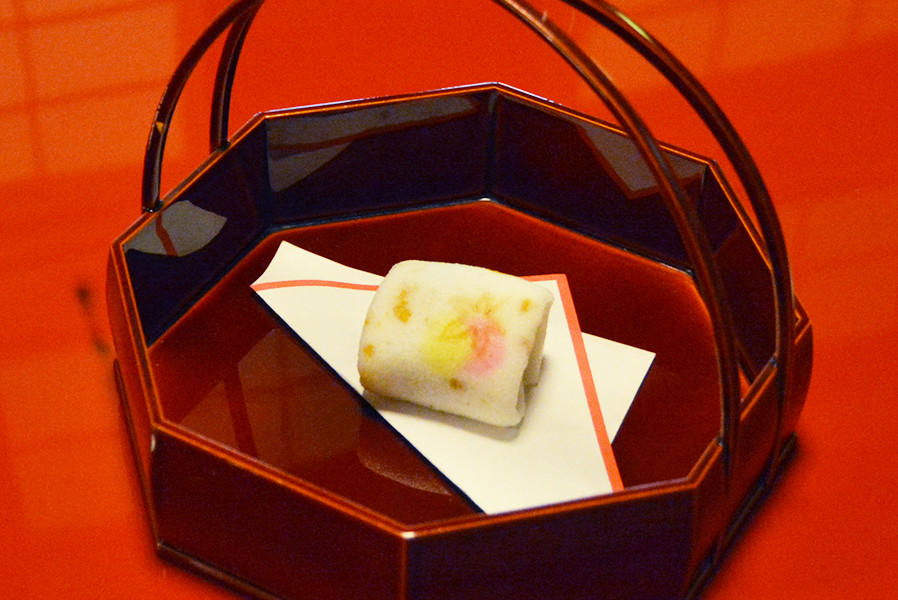
Usu-momiji (Faint Autumn Leaves)
Details: The dried persimmon ornamented on the steamed sweet buns portray the wistful drift of corial diffusing into the vista.
Designated Material: Japanese Yam
Best-before Period : 2 days
Yama Yosoou
Details: The fade of season shifts faces of mountains. The sweet bean paste wrapped in rice cake wafers, are frosted in sweet shreds tinted with season of harvest.
Designated Material: Egg, Japanese Yam
Best-before Period : 2 days
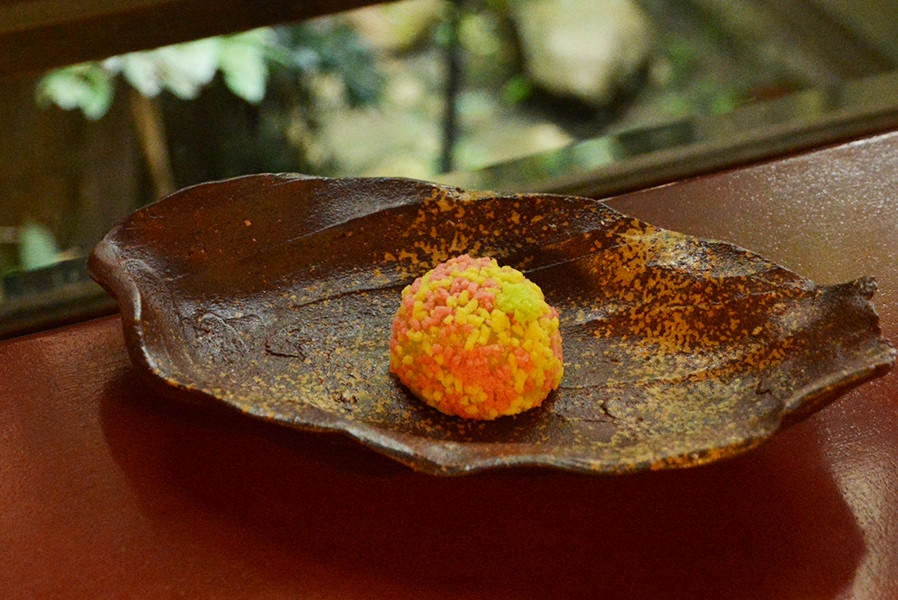
November
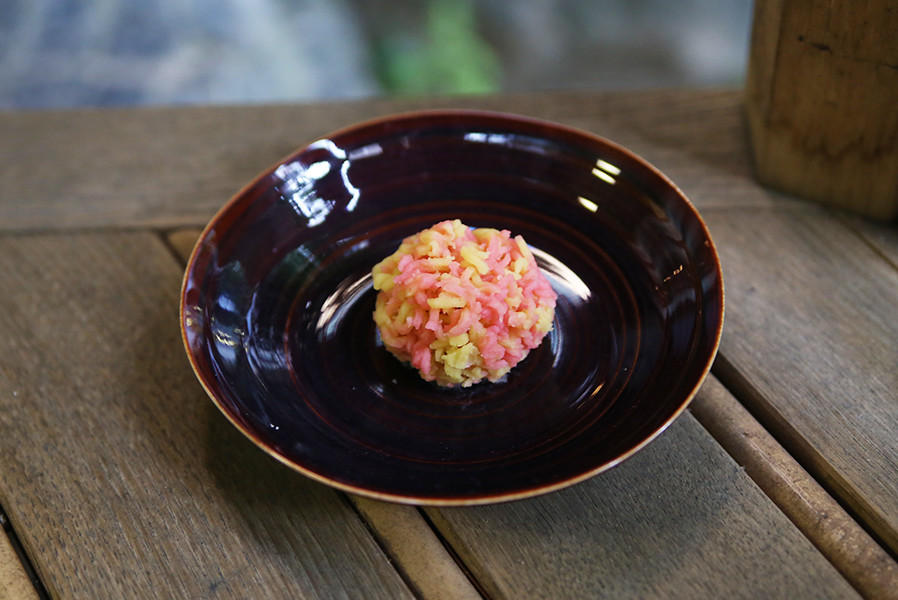
Kin-shuu
Details: The autumn-tinted mountains are splendid, resembling the elegance of Japanese brocades.
Kin-shuu is made of a ball of roughly mashed sweet beans with a layer of smooth sweet bean paste coated around it.
Best-before Period : 2 days
Koro-gaki
Details: The dried persimmons, hung under the eaves of a cottage, gradually turns white during this season, concentrating their sweetness.
Koro-gaki is made with dried persimmons mixed in baked sweet beans, wrapped in rice cake wafers.
Designated Material: Egg
Best-before Period : 2 days


Kasane momiji
Details: Along with the deepening of the fall foliage, the autumn leaves layering on top of another creates a scene whose breathtaking beauty increases day by day.
Kasane mojmiji is a ball of sweet bean paste coated with konashi, sweet baked bean pastes soft enough to be molded by hand, and pressed into the shape of an autumn leaf with a wooden cutter.
Designated Material: Flour
Best-before Period : 2 days
Meoto-jika
Details: The sound of stags calling out to their loved ones among the colours of Autumn was often an inspiration to Japanese poets in the ancient days.
A devoted deer couple is depicted on Meoto-jika with bracken starch.
Best-before Period : 2 days
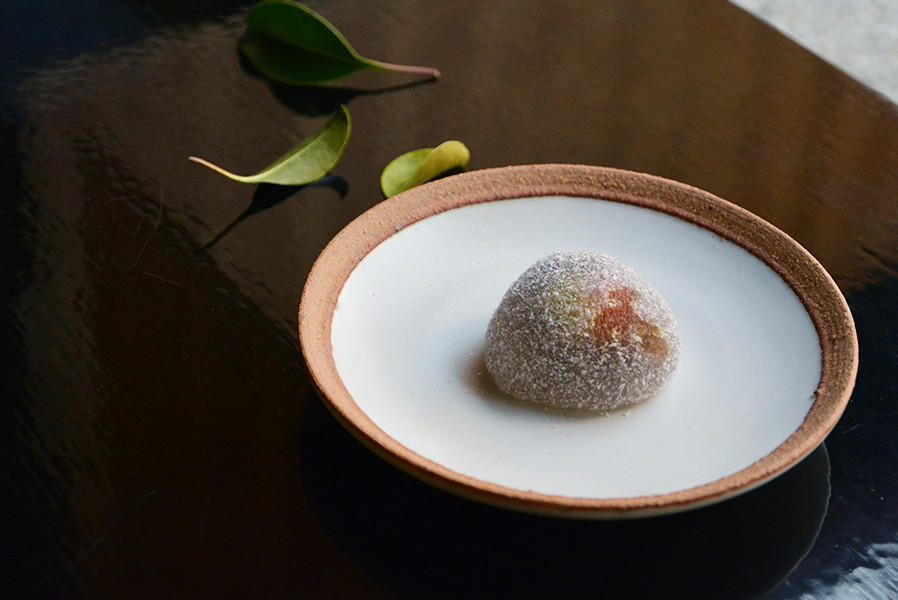

Otome-giku
Details: Grated Japanese yam paste shaded in pink, resembling the touching beauty of a flower blooming in the shade.
Designated Material : "Japanese yam”
Best-before Period : 2 days
Momiji-no-Ga
Nerijyo-yoan, potato paste made of Jyo-yo potato, on top of black-sesame flavored sweet bean paste, depicts the celebrations held under the trees blooming with autumn colors.
Designated Material : Japanese yam, Sesame
Best-before Period : 2 days
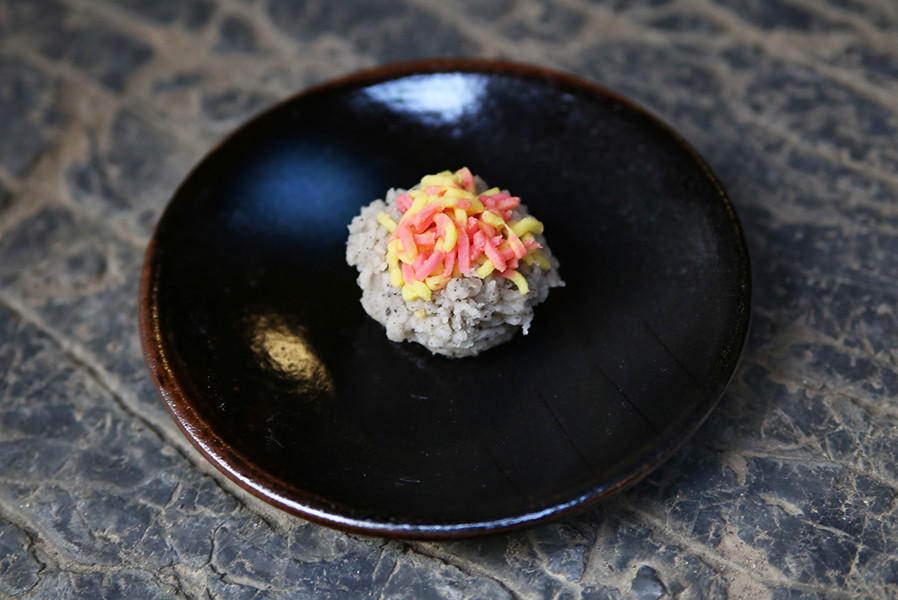
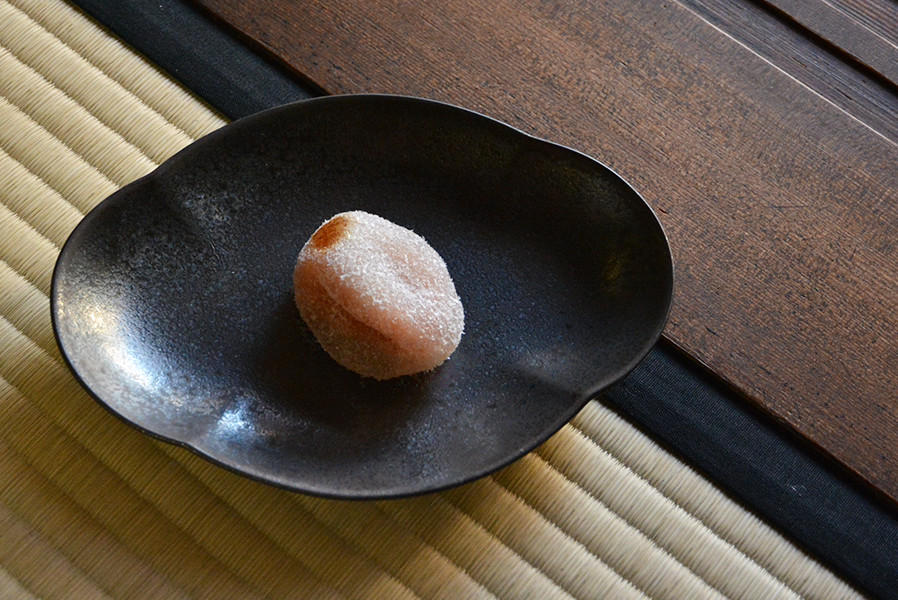
Koro-gaki (Dried Persimmon)
Drying a peeled, sour persimmon by exposing it to the northern wind, takes away the sourness and sweetens it.
Koro-gaki is made by mixing dried persimmons into baked sweet beans paste, and wrapping it with wafers of braken starch.
Best-before Period : 2 days
Miyamaji (Autumn-tinted mountain)
Karukan (steamed sweet bun made from grated yam and rice flour) wrapped in baked sweet beans, expresses the beauty of deepening autumn colours along mountain paths.
Designated Material: Japanese yam
Best-before Period: 2 days

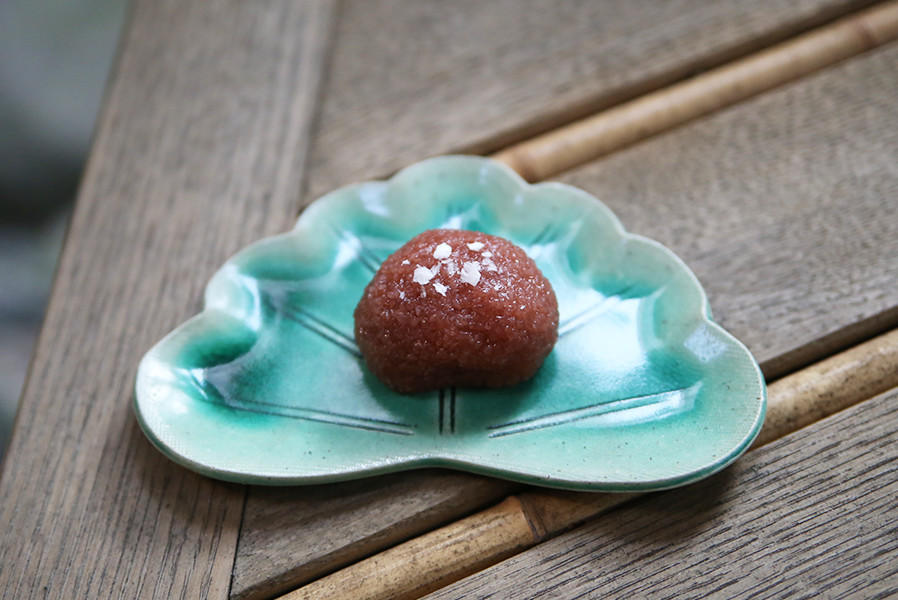
Hatsu-shimo
As Autumn deepens, the first signs of frost make their appearance at dawn.
Sweet red bean paste wrapped in roughly pounded rice cake flavored with red bean broth, ornamented by Koori-mochi (Dried rice cake), represents the arrival of winter.
Best-before Period : 2 days
Chiri Ichyou
Of all the trees covered in the colours of autumn, the golden leaves of the ginkgo tree stand out. The fallen leaves provide a spectacular sight.
Chiri Ichyou is made by folding sweet rice jelly around roughly mashed sweet beans pastes.
Designated Material: Flour
Best-before Period : 2 days
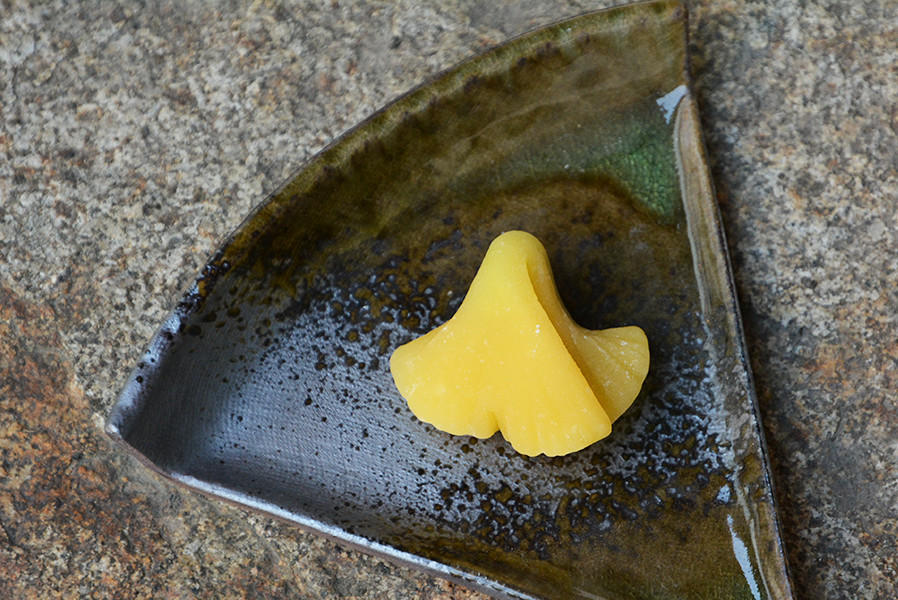
December
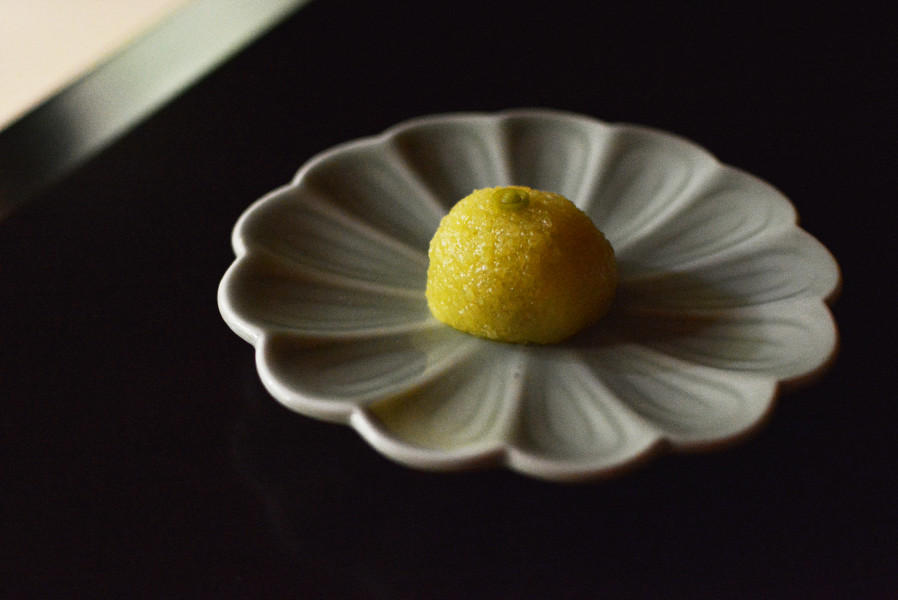
Yuzu-mochi (Citron rice cake)
The custom of wishing for children's health by eating pumpkin and bathing in yuzu-yu (citrus bath) on winter solstice still remains.Yuzu-mochi is made with baked sweet beans wrapped in yuzu (citrus) scented with domyouji (a type of rice cake with lumpy texture), and shaped into a citron.
Designated Material : Flour, Soybeans
Best-before Period : 2 days
Souyou
The autumn leaves tinted in red, orange, and yellow in the frost as it deepens day by day is more beautiful than any flower. The nerijyo-yoan, potato paste made of Jyo-yo potato frosted around a ball of smooth sweet bean paste depicts the elegance of winter.
Designated Material : Japanese yam
Best-before Period : 2 days
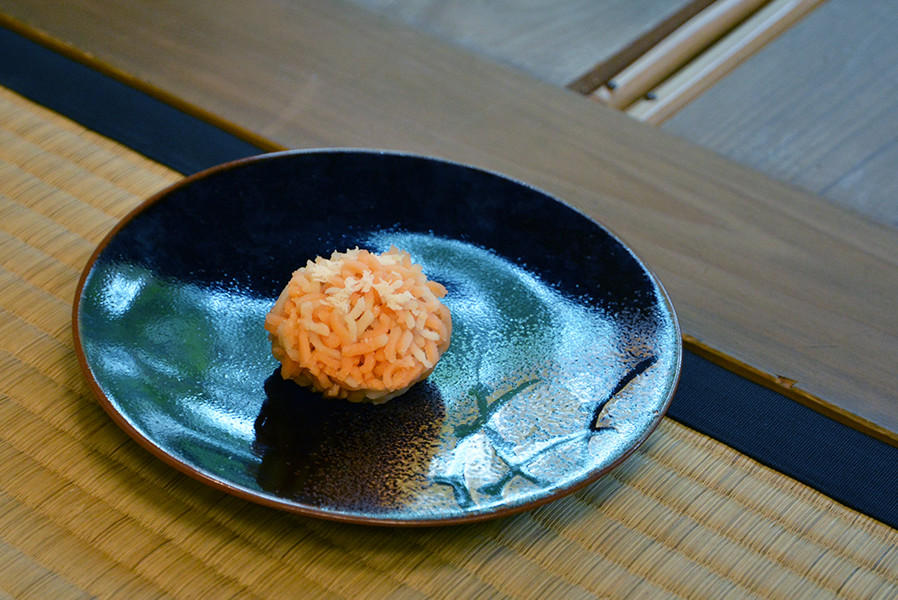
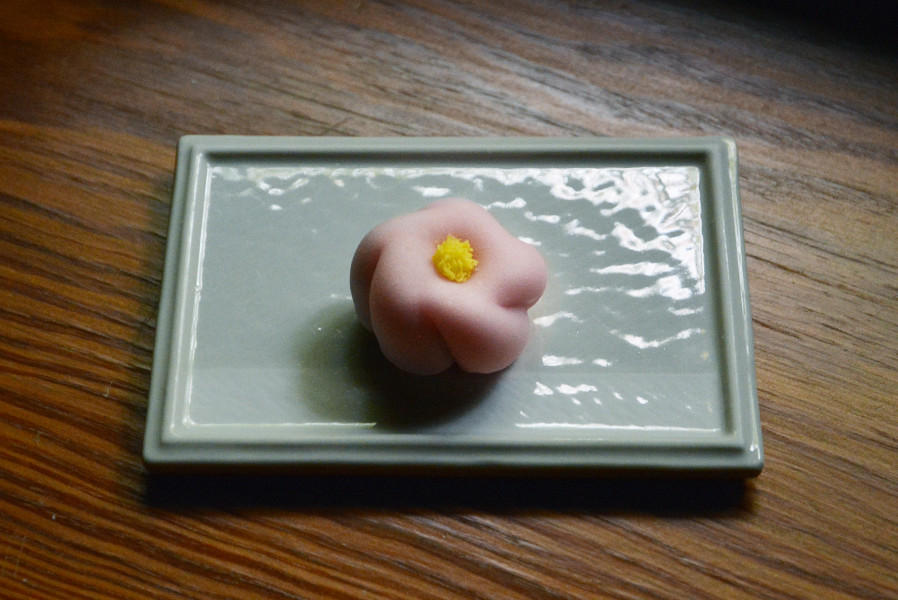
Sazanka
The sasanka flourishes from late autumn through early spring. The sweet baked bean paste and white bean paste wrapped in rice cake wafers, with yellow Nerijyo-yoan (potato paste made of Jyo-yo potato as the stem) is made into the shape of sasanqua.
Designated Materia: Egg, Japanese Yam
Best-before Period: 2 days
Suisenka
The narcissus with white petals and yellow corolla blooms gracefully in the severe cold. Sweet bean paste wrapped in colored konashi (soft sweet baked bean paste molded by hand) is shaped into a flower.
Designated Material : Flour, Japanese yam
Best-before Period : 2 days
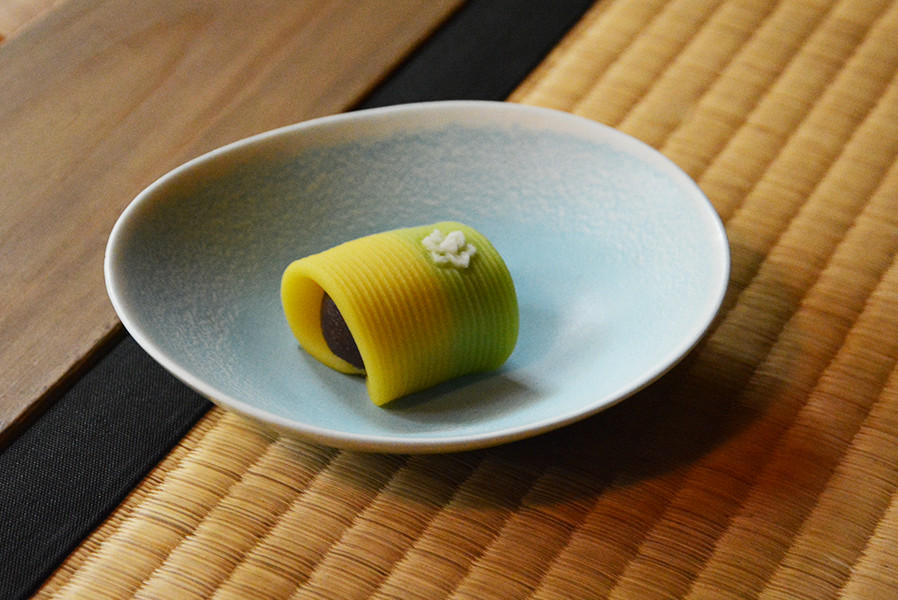
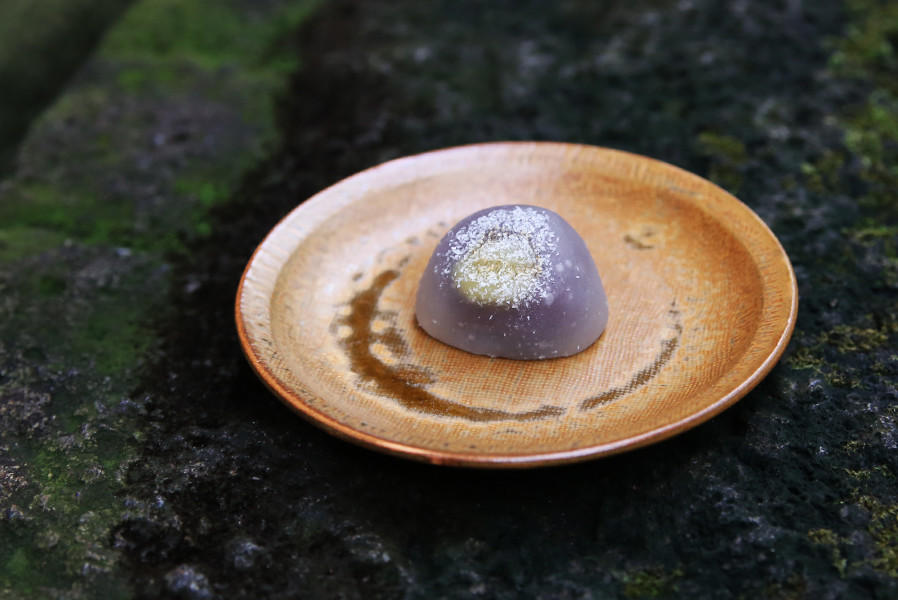
Fuyu no Iori
The beautiful view of a cottage in the autumn scenery will soon face a harsh winter. Mashed sweet bean paste wrapped with bracken starch depicts the wabi (purity of poverty and simplicity) of the shifting seasons.
Best-before Period : 2 days
Yuzu-mochi
The custom of wishing for children's health by eating pumpkin and bathing in yuzu-yu (citrus bath) on winter solstice still remains.
Yuzu-mochi is made with baked sweet beans wrapped in yuzu (citrus) scented with domyouji (a type of rice cake with lumpy texture), and shaped into a citron.
Designated Material : Flour, Soybeans
Best-before Period : 2 days
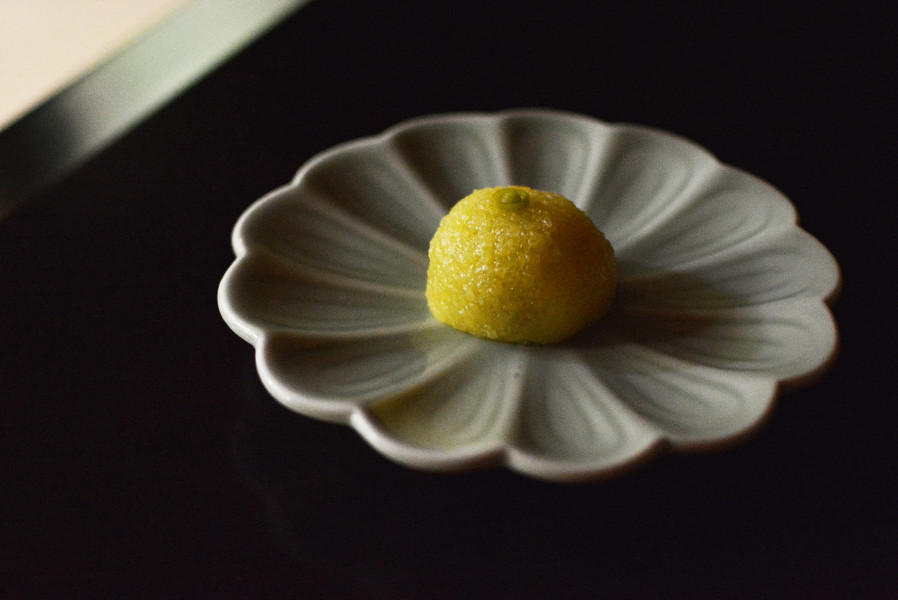
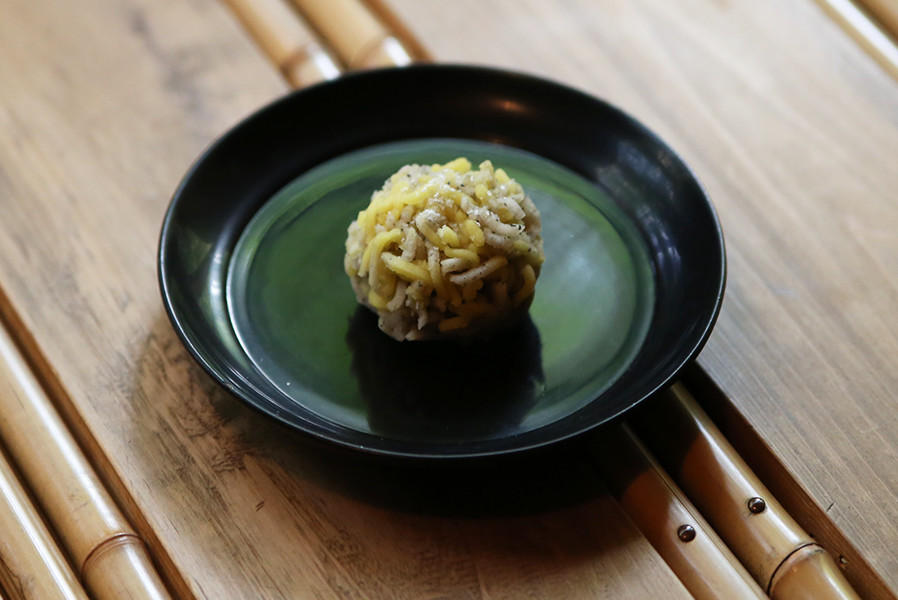
Fuyu-garez
The solitary winter scenery with withered plants and the voices of insects dying out. Sweet smooth bean paste with sesame expresses the chill brought by the north wind.
Designated Material : Sesame
Best-before Period : 2 days
Fuyu Tsubaki
In the ancient past, people regarded camellia as one of the flowers blooming in spring. The camellia flourishing in early winter is shaped by sweet rice jelly coated around smoothly mashed sweet bean.
Designated Material : Flour
Best-before Period : 2 days
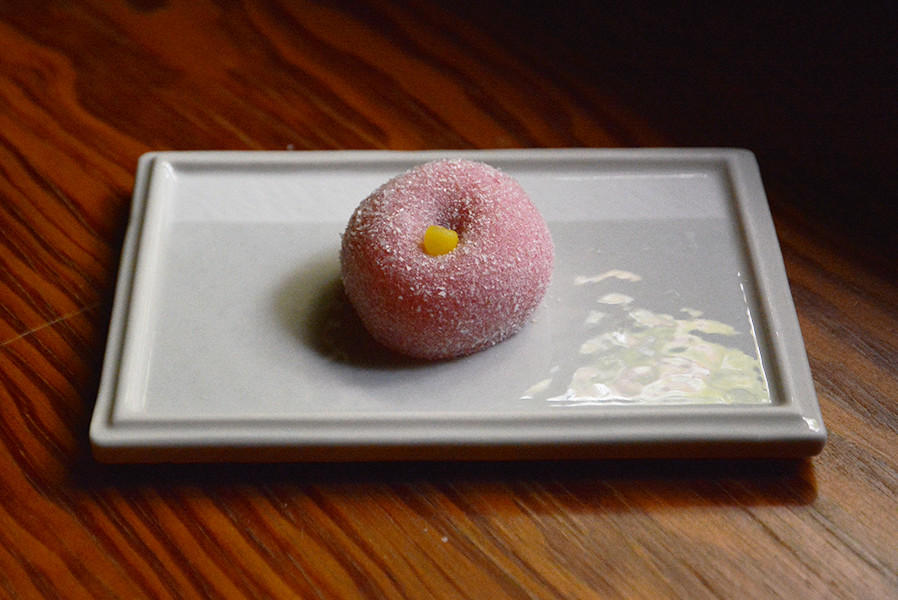
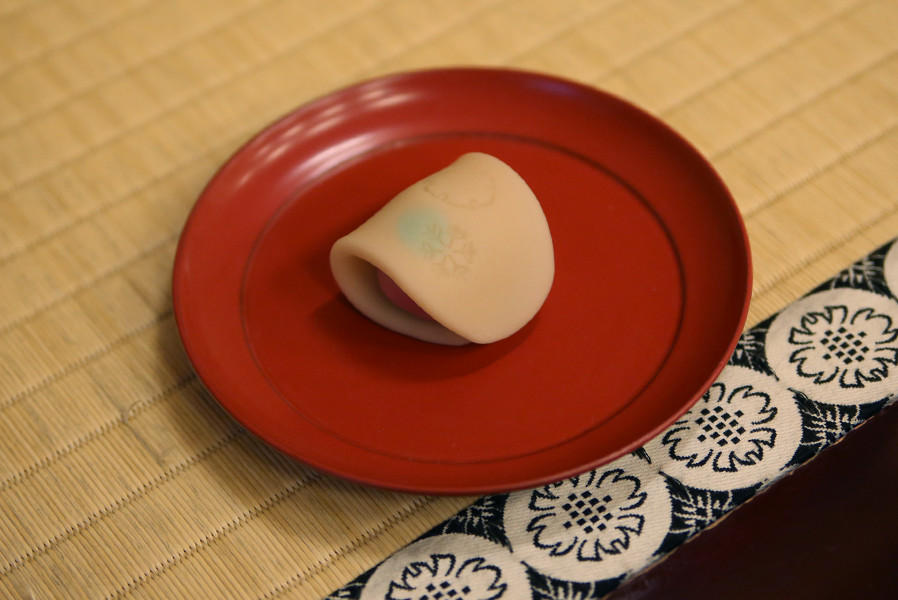
Yuki no Hana
In the ancient times, snow was thought to be an auspicious sign of an abundant harvest. The Nerijyo-yoan (potato paste made of Jyo-yo potato), is wrapped around the pink tinted white bean paste, with the silhouette of a snow flake stamped on it.
Designated Material : Flour, Japanese yam
Best-before Period : 2 days
Wara-zuto
Details: Paeonia suffrutticosa flourishes in the middle of the winter, just before the flowering season. Sweet mashed bean paste wrapped in grated yam shaded in pink depicts a paeonia suffrutticosa flourishing in the wara-gakoi (a covering made of straw to protect from the cold).
Designated Material : Japanese yam
Best-before Period : 2 days



